15 Million Years Ago
Wasatch Mountains are Born
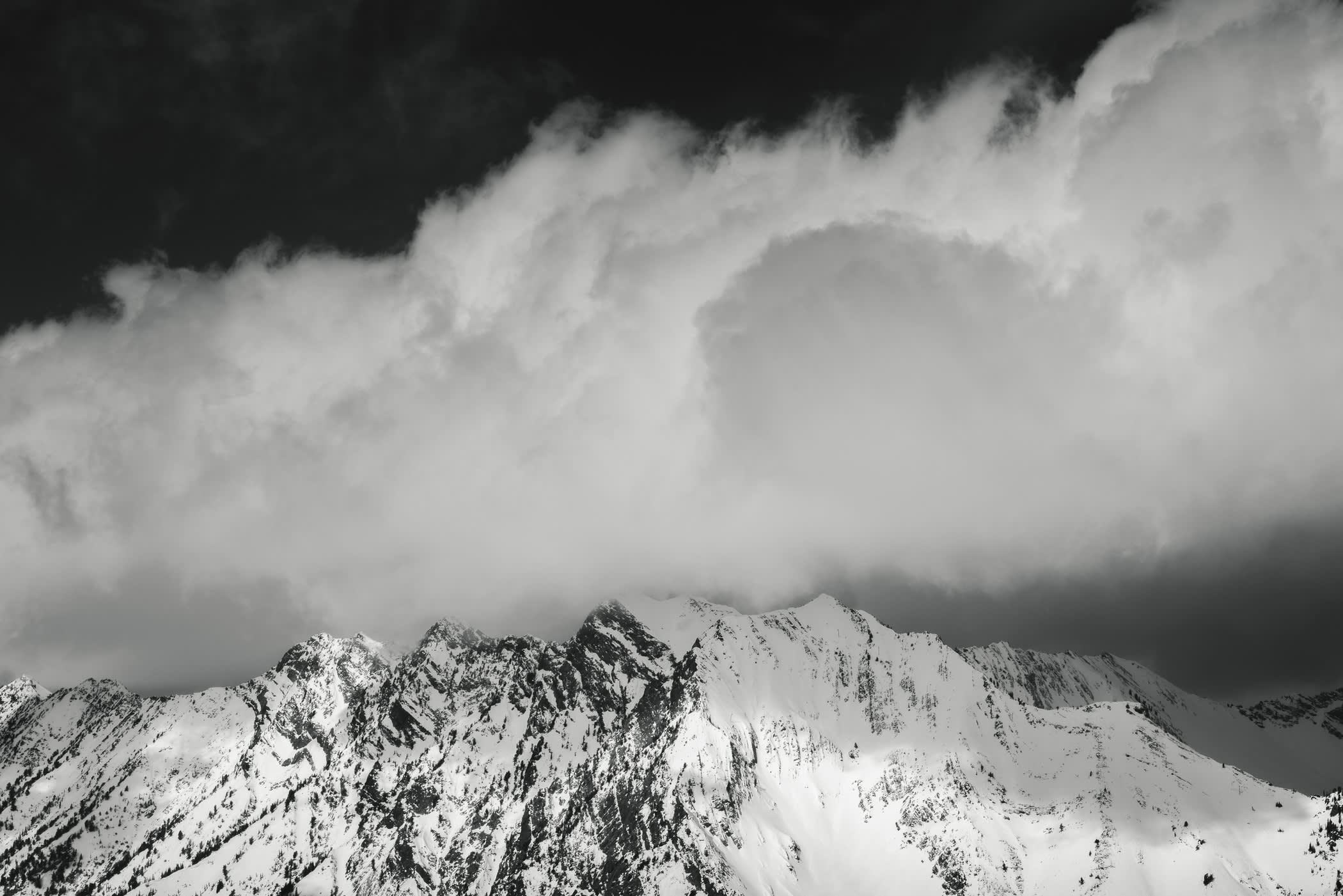
The Wasatch Mountains are thrust upward from the Earth’s crust around 15 million years ago due to a violent collision between tectonic plates.
30,000 Years Ago
A Frozen Landscape
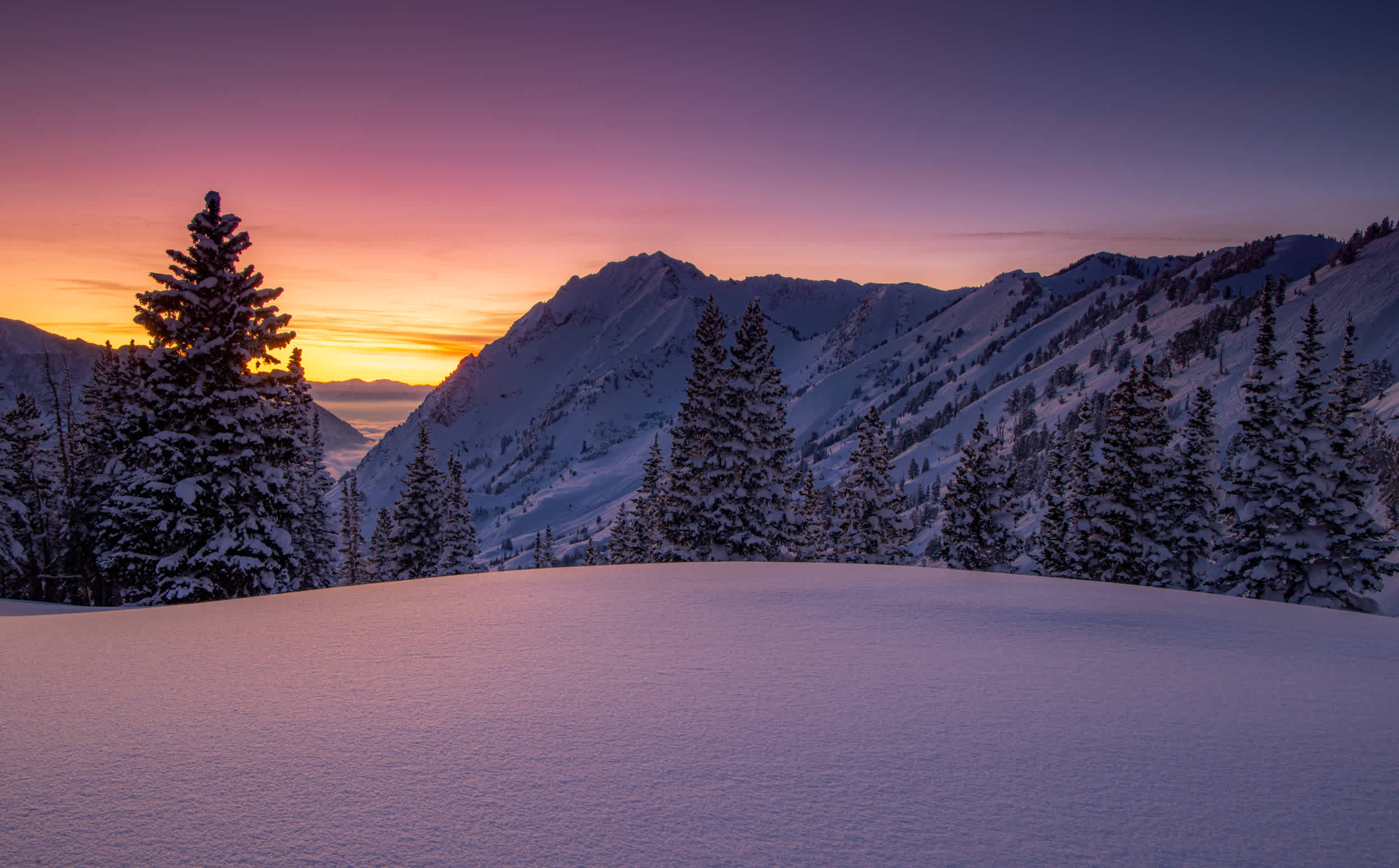
Pleistocene era glaciers, hundreds of feet thick, carved the high alpine basins of today’s ski runs at Alta and the dramatic U-shaped profile of the Little Cottonwood Canyon. It is believed that the glacier once reached beyond the mouth of the canyon extending into Lake Bonneville, where it may have calved icebergs into the ancient lake.
13,000 Years Ago
Indigenous Activity
For thousands of years, the Wasatch Mountains offered summer hunting and fishing grounds to roaming bands of Indigenous peoples including the Ute Indians, Tribes of Shoshoni and Gosiute and the more ancient Fremont Culture.
1850
Early Activity in Little Cottonwood Canyon
The earliest Mormon settlers relied on Little Cottonwood Canyon for its abundant timber and water. Beginning in 1855, granite was quarried by the pioneers at the mouth of the canyon to be used in the construction of their Salt Lake Temple.
1864
Silver Discovered in Little Cottonwood Canyon
In July of 1864, General Patrick E. Connor discovered argentiferous (silver) ore at the head of Little Cottonwood Canyon. Mining activity intensified in the following years.
1871
Alta Becomes a Mining Town
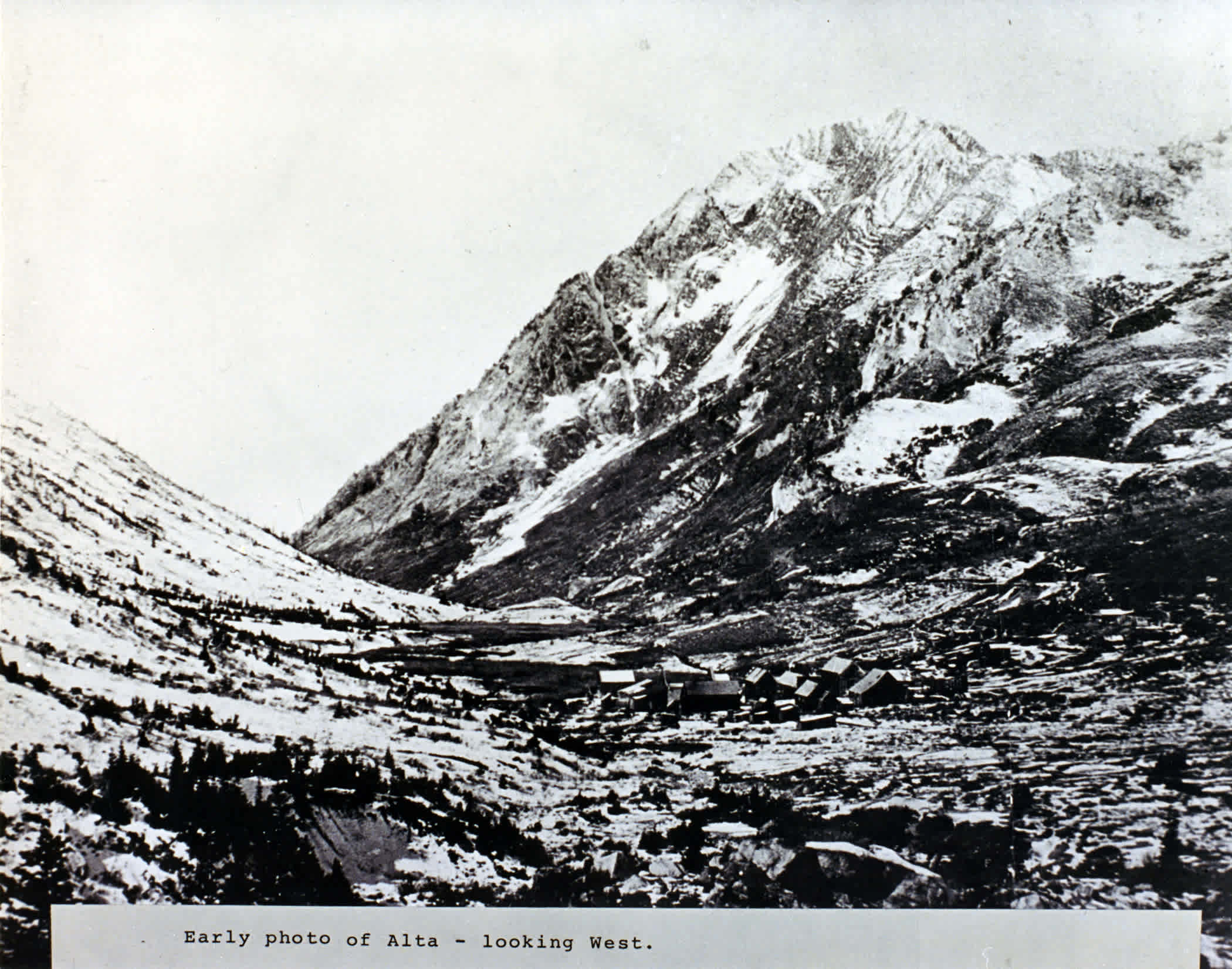
Following the discovery of silver in the 1860s, miners began inhabiting the upper elevations of Little Cottonwood Canyon. By 1873, the number of mine claims totaled around 2,100 and the temporary summer population hovered between 5,000 to 8,000 individuals, representing Alta’s peak.
1876
Mule-Drawn Railroad to Alta is Completed
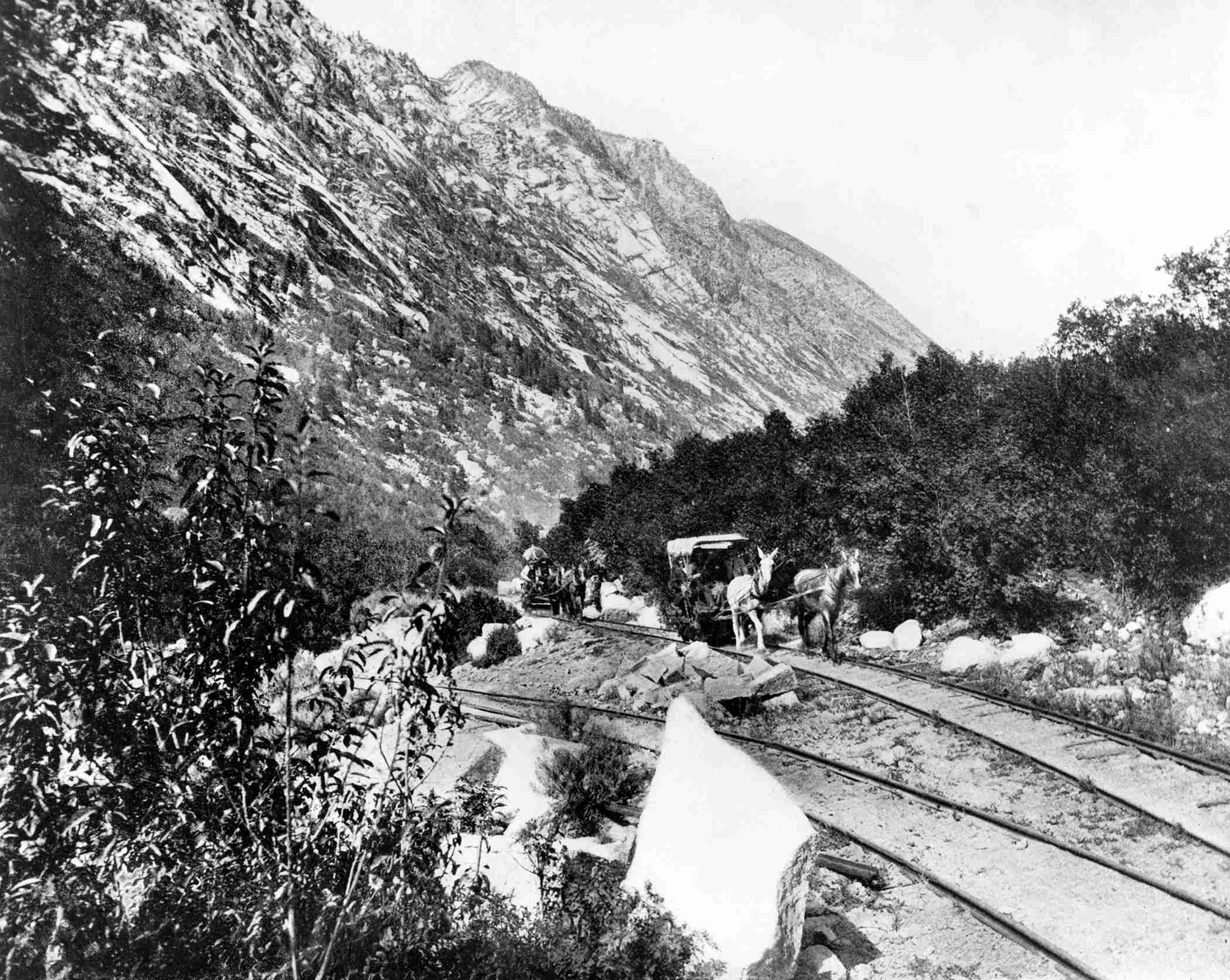
Miners built a mule-drawn railroad to haul silver ore from Alta to the Salt Lake Valley.
1885
Town of Alta Destroyed by Avalanche
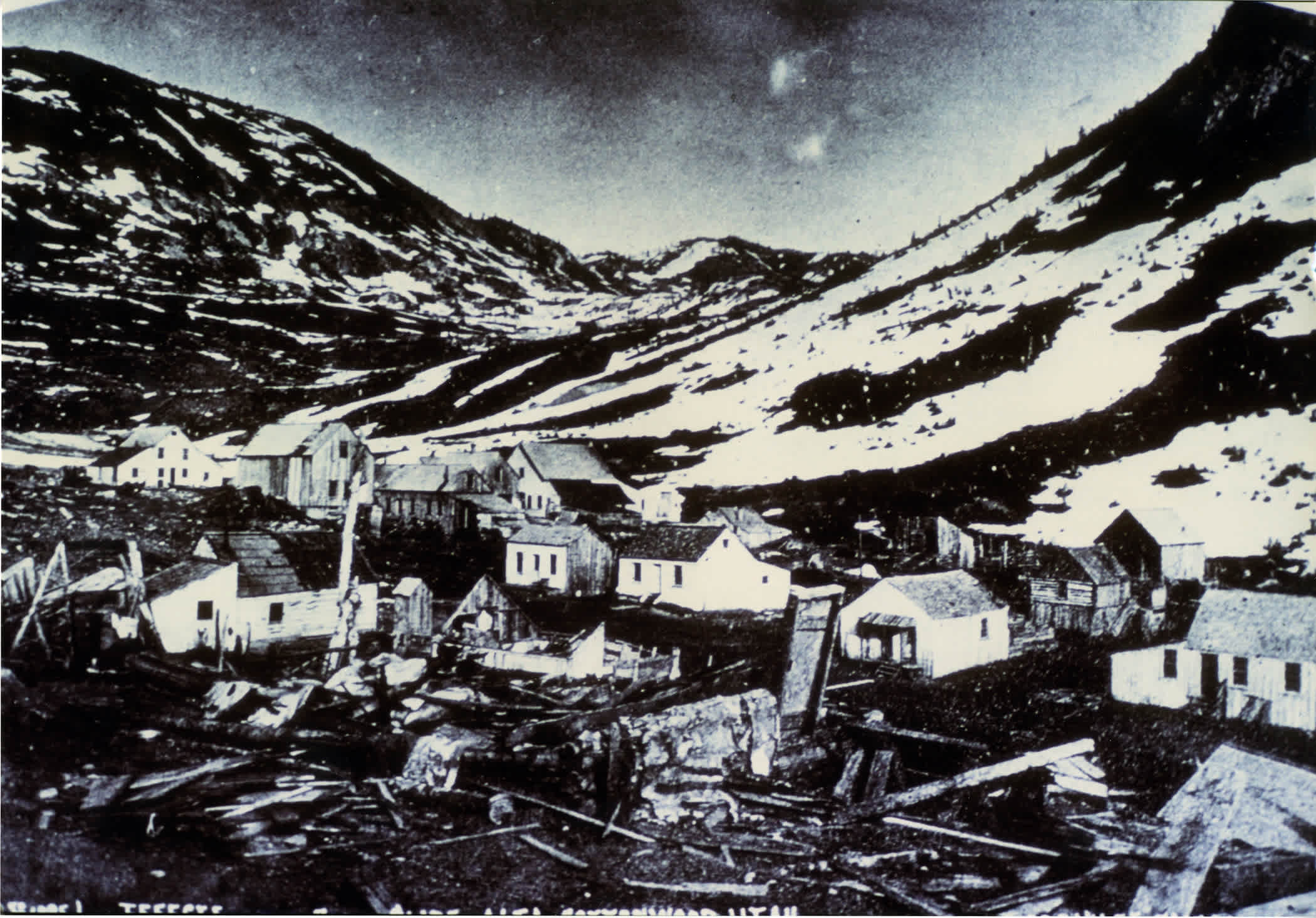
In the evening hours of February 13th, a massive avalanche buries the town of Alta under 50 feet of snow, killing 16 residents and leaving only 7 structures unharmed.
1919
Railroad to Alta completed
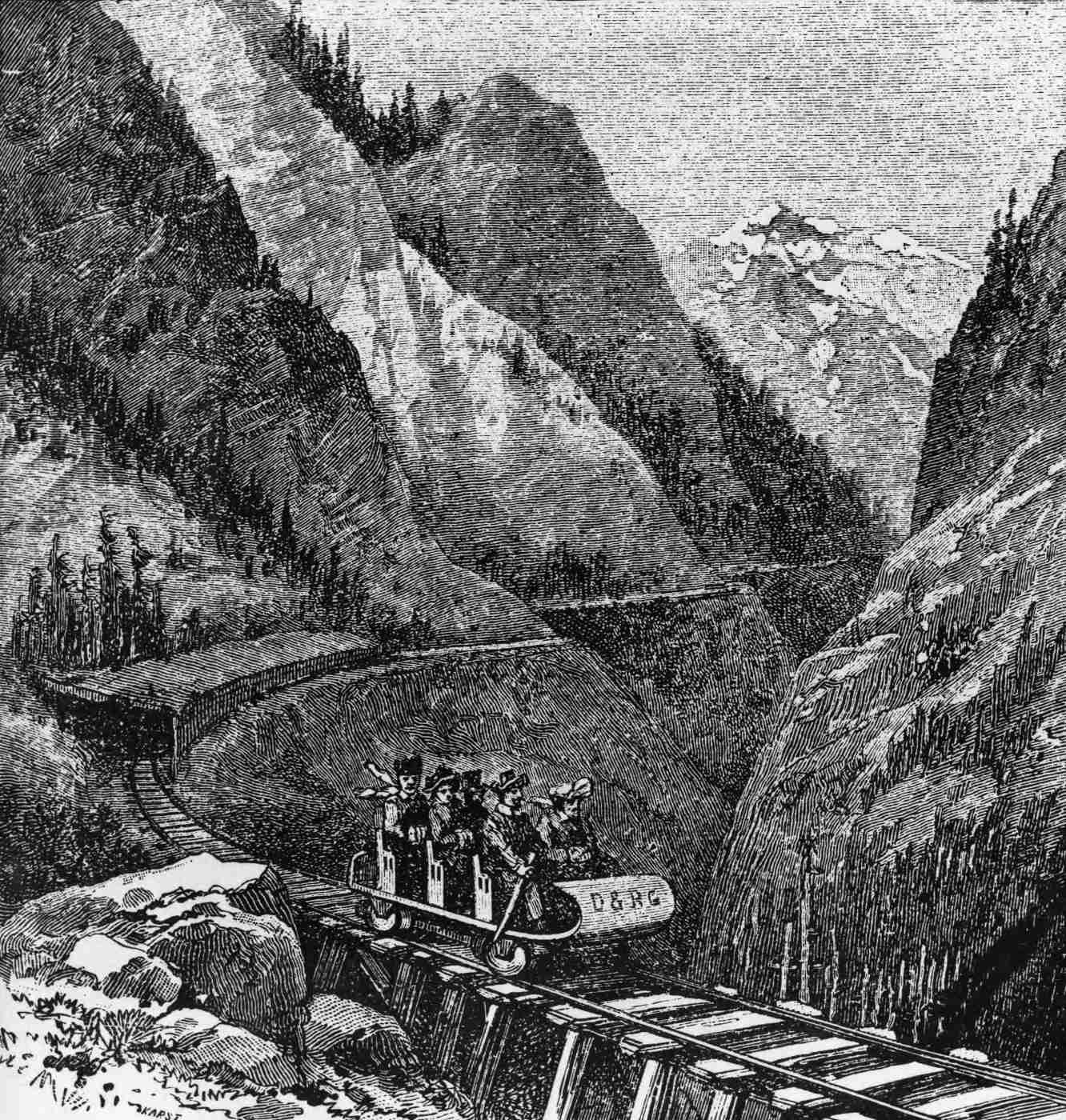
Denver Rio-Grande finishes the narrow-gauge railway to Alta, lying atop the old mule-drawn railroad of the early mining era.
1920
Mining Era fizzles out
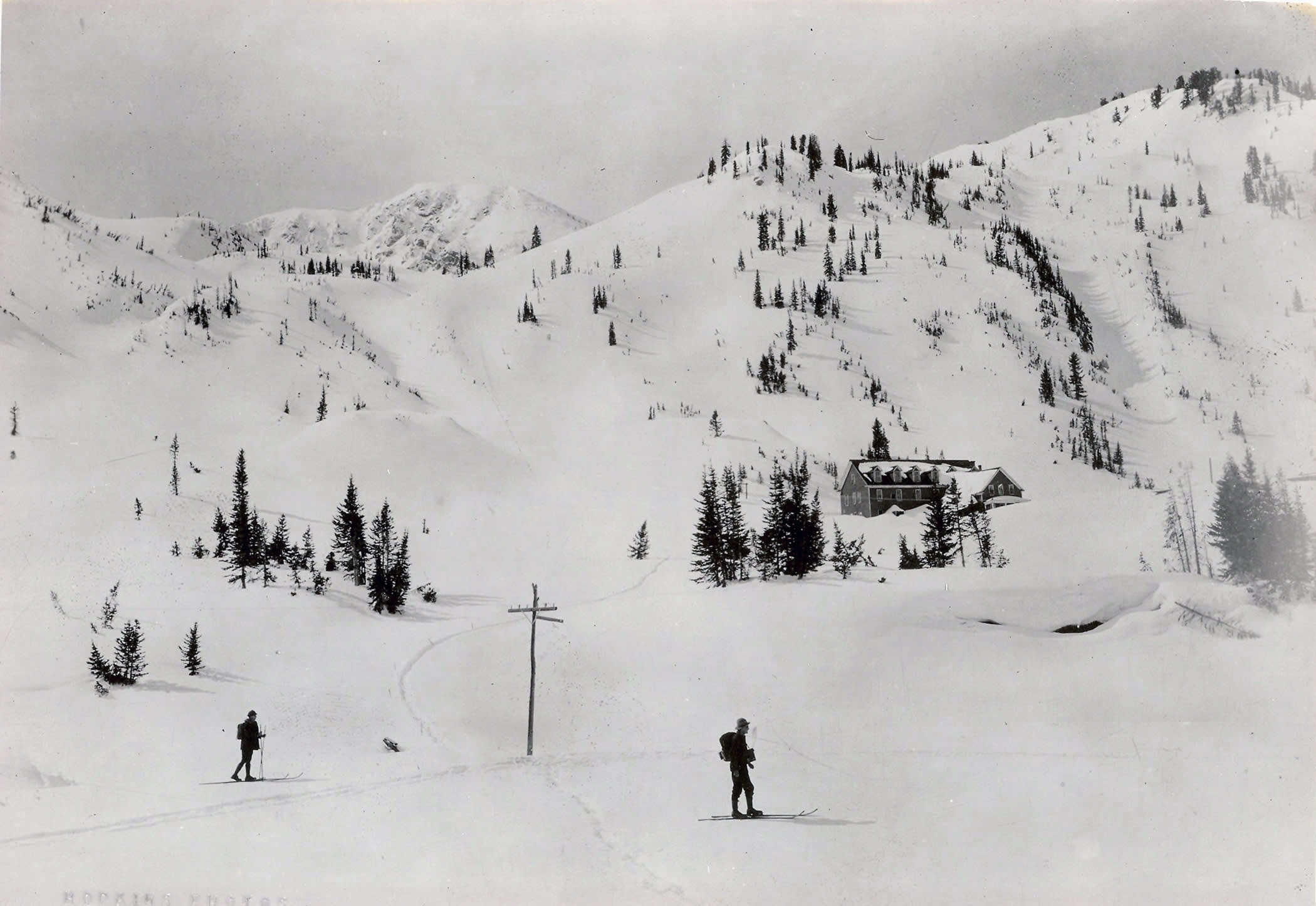
As an economic depression deepens, mines are abandoned. George Watson finds himself the sole resident of Alta—he declares himself mayor.
- Members of the Wasatch Mountain Club visit Alta for primitive backcountry skiing forays.
- By 1922 “Mayor” Watson operated the railway as the Alta Scenic Railway to stoke tourism to “Romantic Alta” with underground tours of the old Emma Silver Mine.
1935
Alf Engen was hired by the US Forest Service
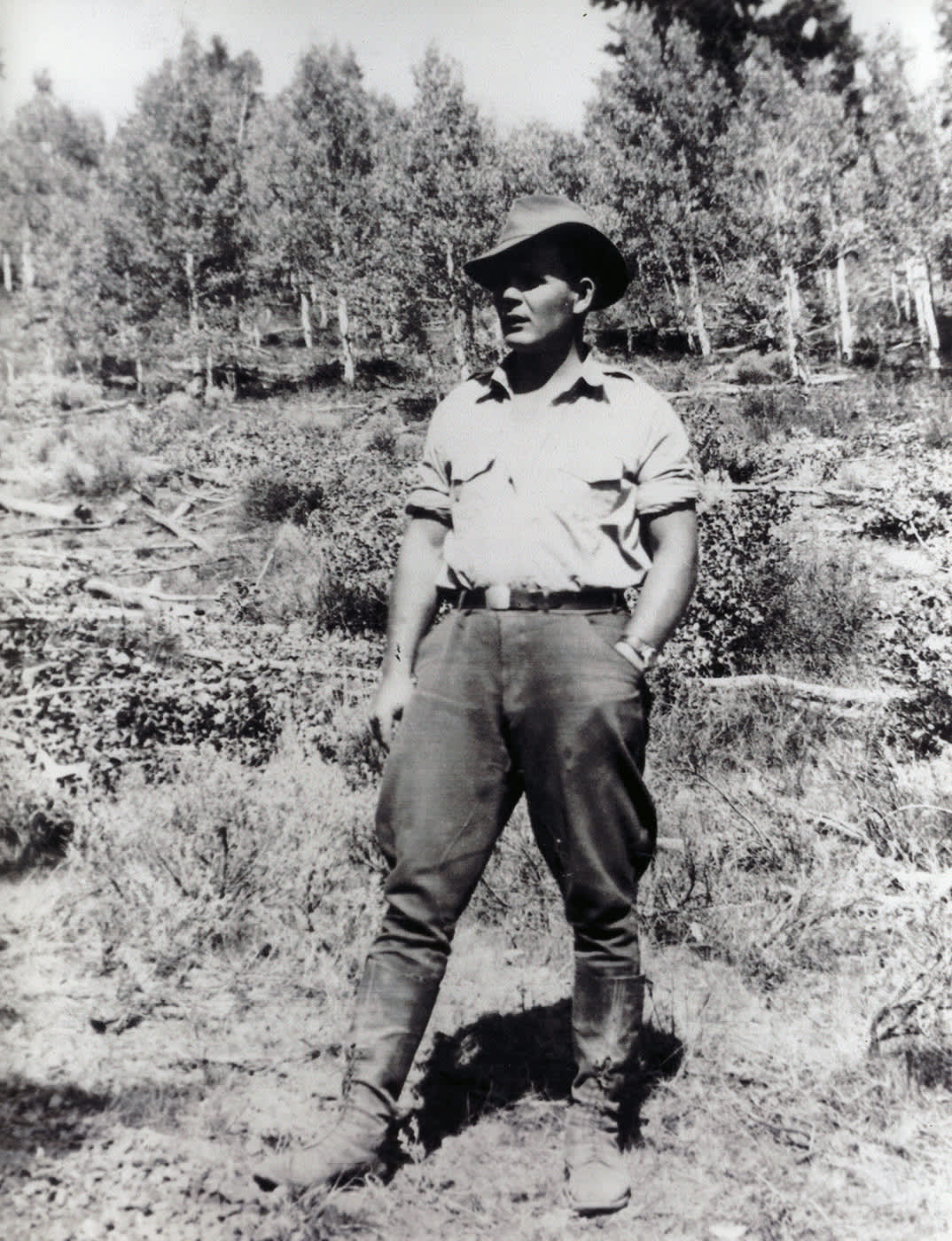
World champion Norwegian ski jumper, Alf Engen, is hired by the United States Forest Service (USFS) to determine potential winter recreation sites in Salt Lake’s surrounding mountains. Engen skis to Alta via Big Cottonwood Canyon and Catherine’s Pass to spend a few days with the Jacobsen brothers who were mining in the area. After another summertime visit, Engen recommends Alta as a prime site for winter recreation.
- With Engen’s encouragement, the Civilian Conservation Corps began planting trees on the denuded slopes of Alta to reduce avalanche hazard and rehabilitate the watershed, decimated by mining, timber removal and grazing.
1936
Road to Alta is completed
An improved motor road to Alta is constructed in Little Cottonwood Canyon along the abandoned railway grade.
1937
George Watson deeds land to the USFS
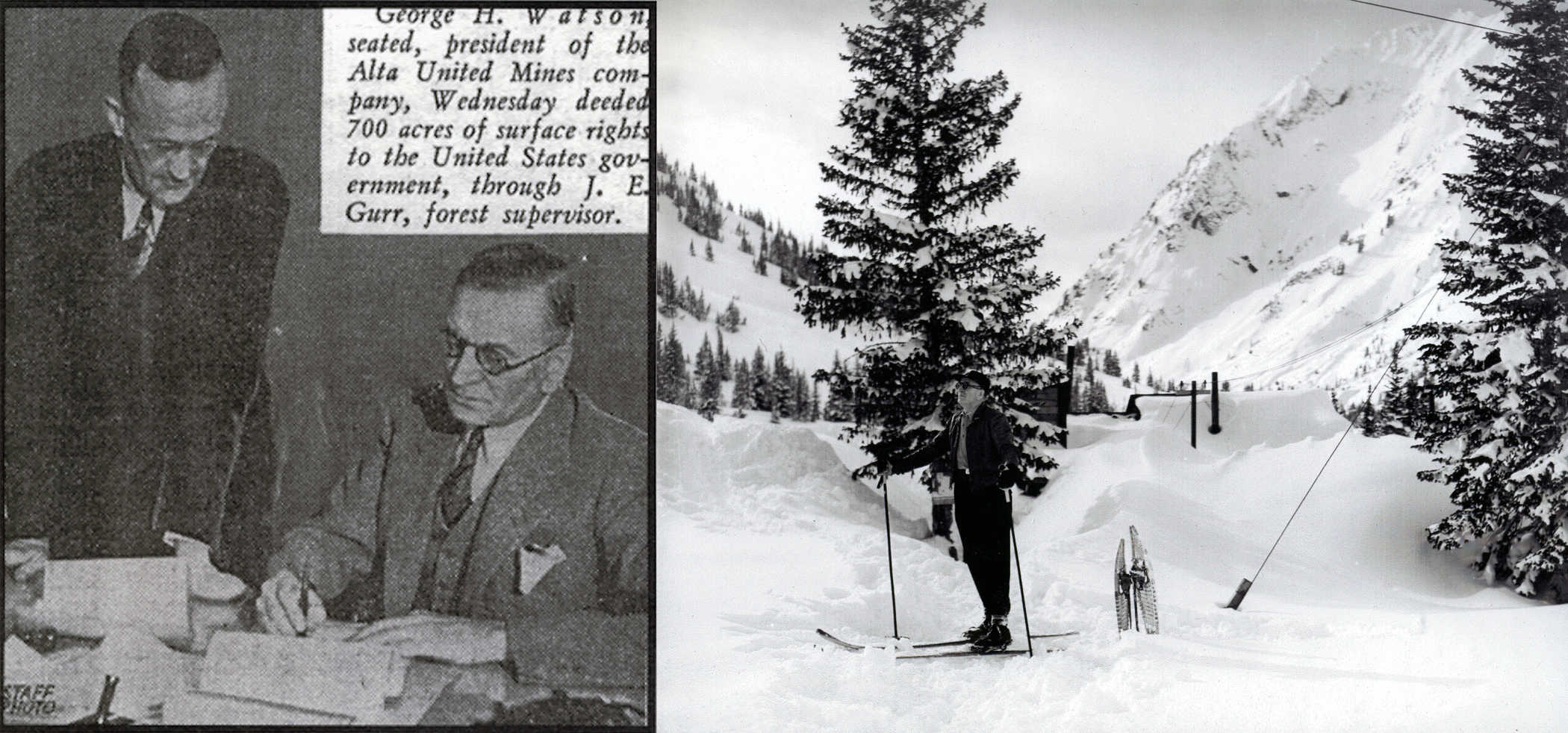
To ease the tax burden incurred from buying defunct mining claims, George Watson deeds 700 acres of surface rights to the US Forest Service for the purpose of building a ski area at Alta.
- Joe Quinney organizes Salt Lake City Winter Sports Association (WSA).
- Throughout the late 1930s into the 40s, a handful of tow ropes provide limited skiing access for winter enthusiasts.
1938
Alta Ski Area is founded
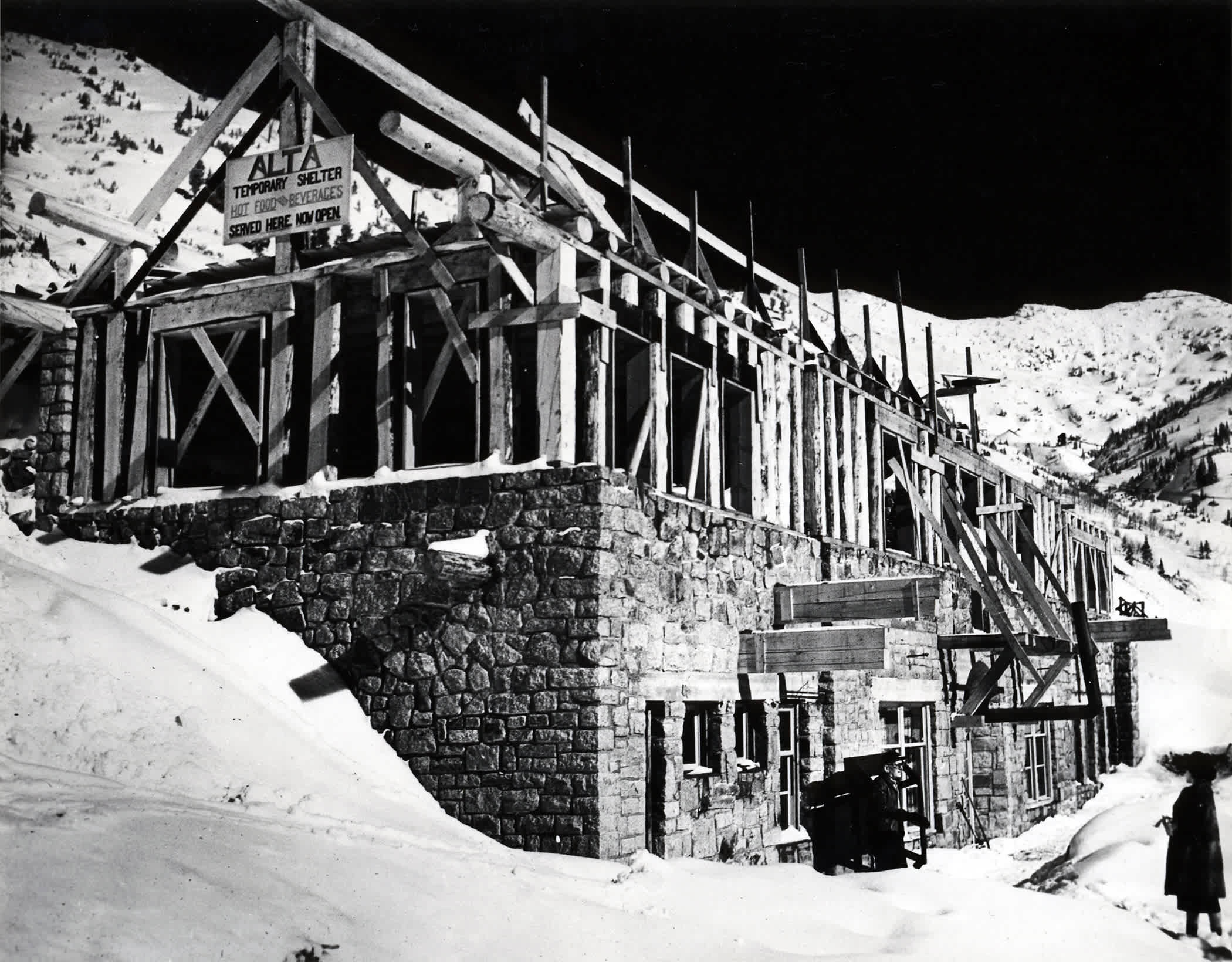
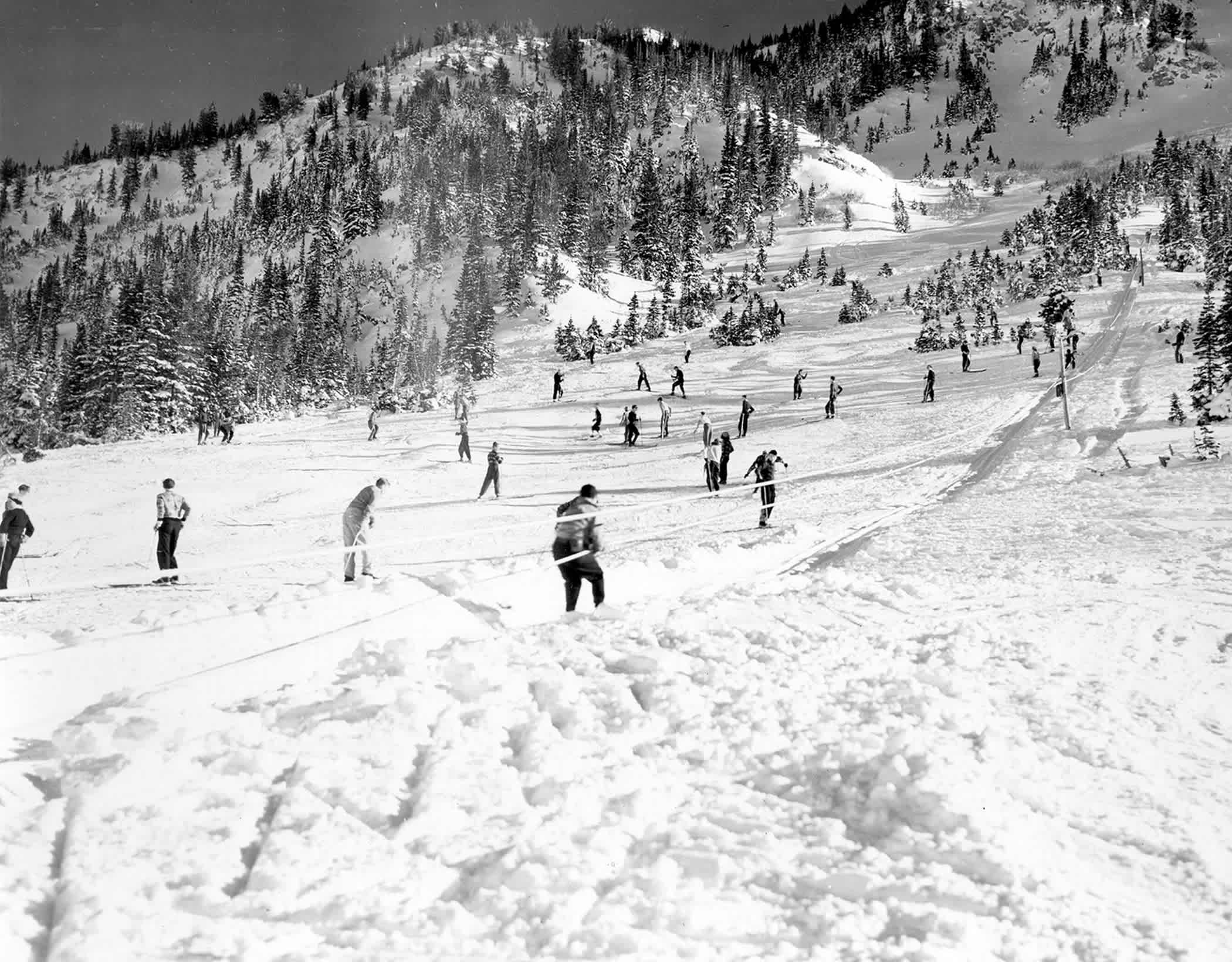
A group of local businessmen—the Salt Lake Winter Sports Association—raises $10,000 to build Collins lift using remnants of old mine trolleys and salvage timber from the mines.
- Karl Fahrner was named the first Ski School Director for Alta.
- The nation’s first Avalanche Research Center was opened at Alta and C. Douglass Wadsworth was hired as the country’s first USFS “Snow and Avalanche Observer” devoted to the study of avalanche science. Wadsworth developed basic safety protocol for travelers and skier, often closing Highway 210 for 1-4 days following a storm.
- The USFS, using Civilian Conservation Corps labor, remodeled and constructed the “Rock Shelter” for skiers from the remnants of the defunct Stillwell General Store from Alta’s mining days. It would later house the ski school and eventually become the Snowpine Lodge.
1939
Alta Ski Area opens on January 15th
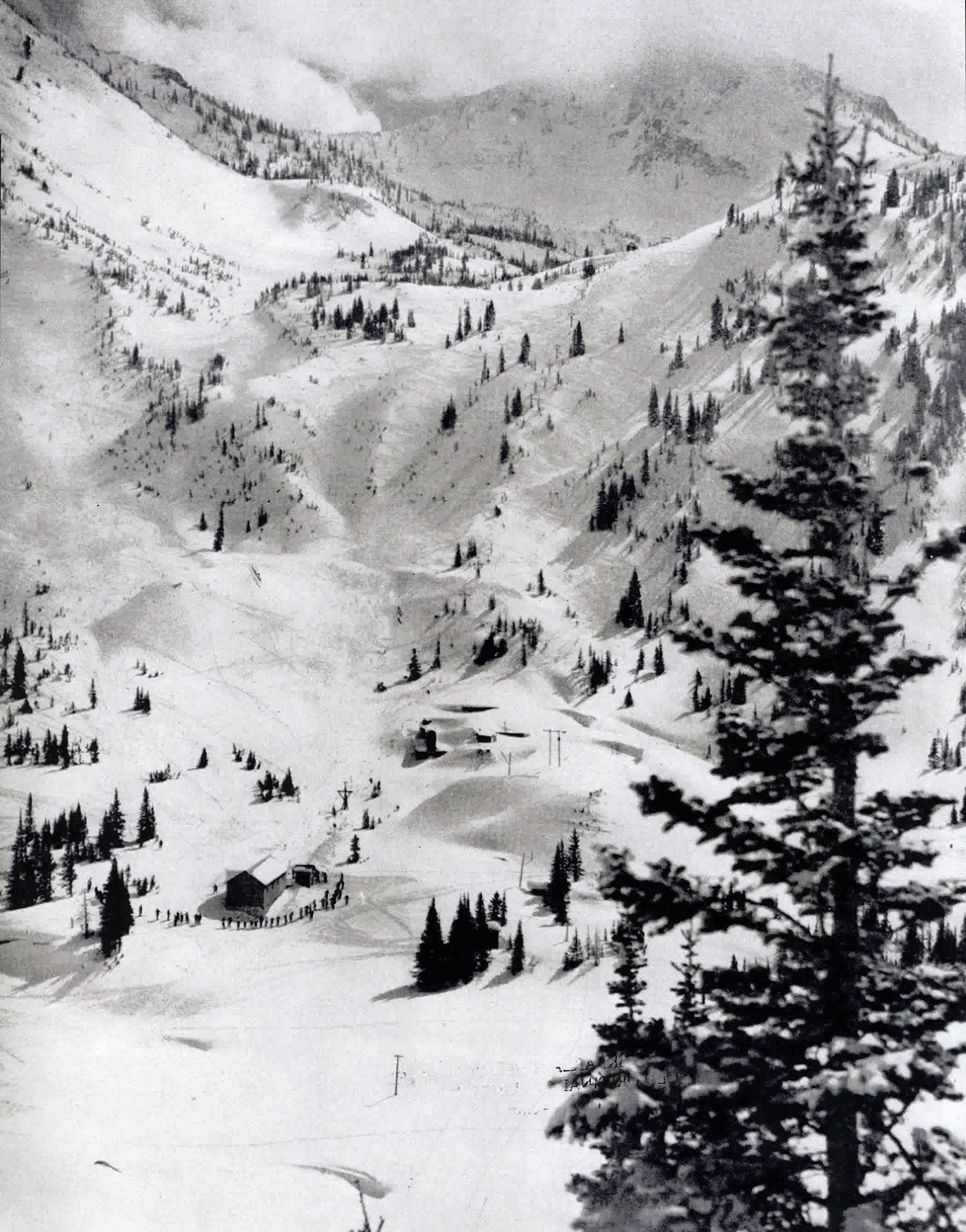
After many delays and complications, the Collins single-chair welcomes skiing enthusiasts as the fourth chairlift in America and the first in Utah. A single six-minute ride costs 25 cents—or $1.50 for a full-day pass.
- Watson’s Forest Lodge—later dubbed Watson’s Shelter—is constructed by the Forest Service to provide skiers with shelter and warm meals near the top of the Collins single-chair
1940
Birthplace of Avalanche Mitigation and Ski Area Development
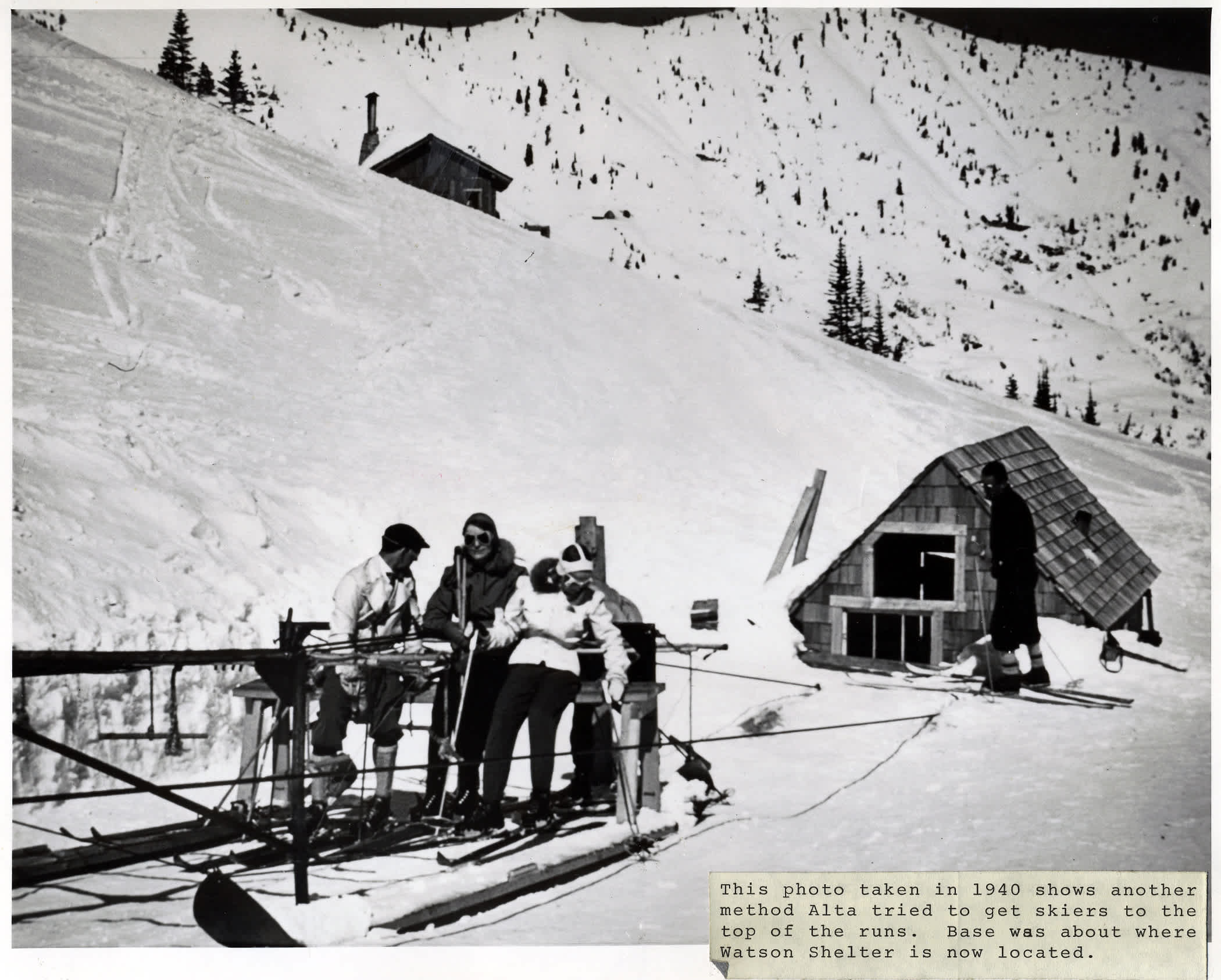
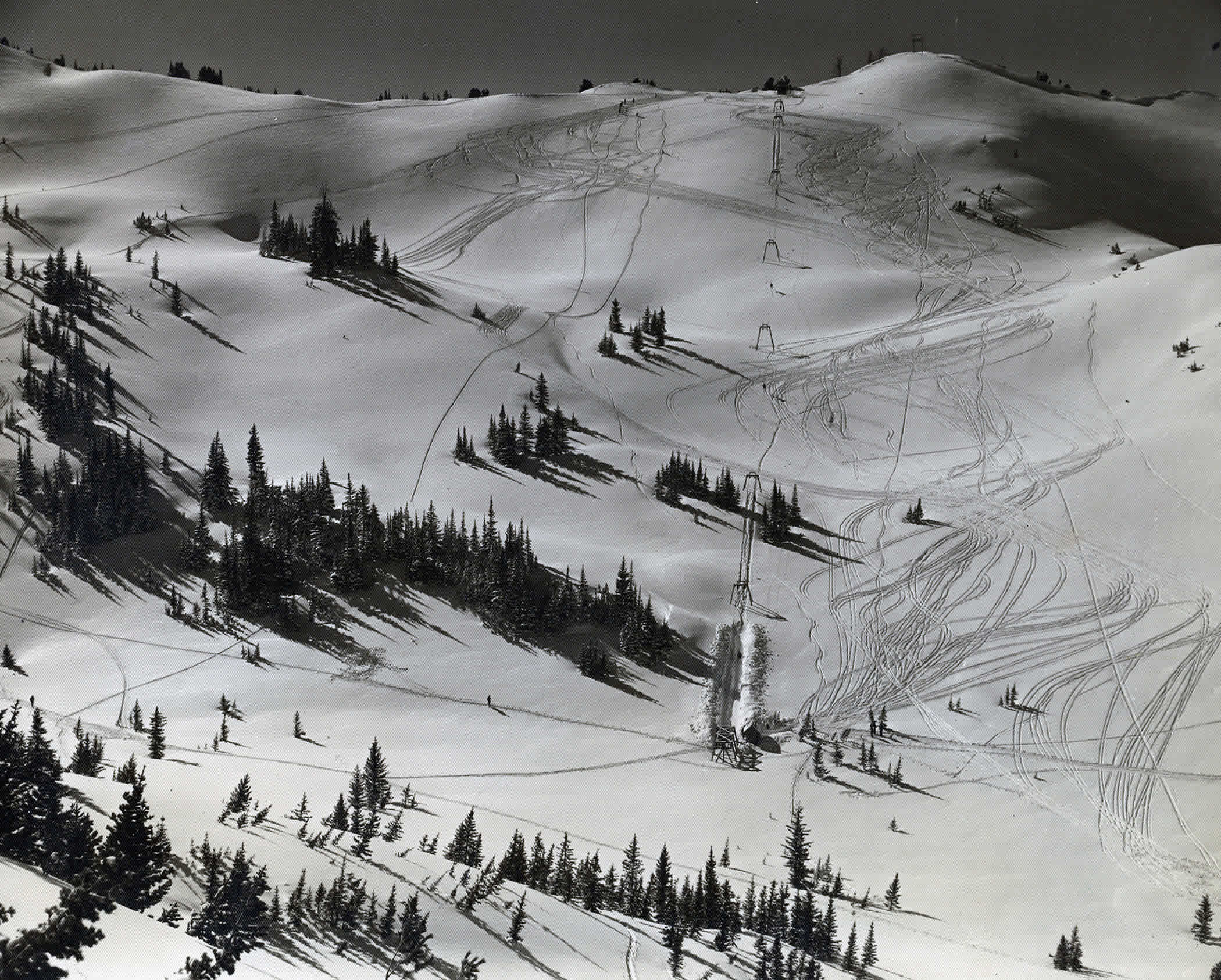
An experimental skier conveyance called “The Barge” is constructed up Aggies Alley. The Red Shelter opens at the base of Collins lift. Alta’s second lift, the now-defunct Peruvian J-Bar, is constructed on the east side of Peruvian Ridge.
- Following C.D. Wadsworth, Sverre Engen uses explosives and ski cuts in avalanche mitigation
- Dick Durrance was named Ski School Director for the 1940–41 season
1941
The Alta Lodge opens
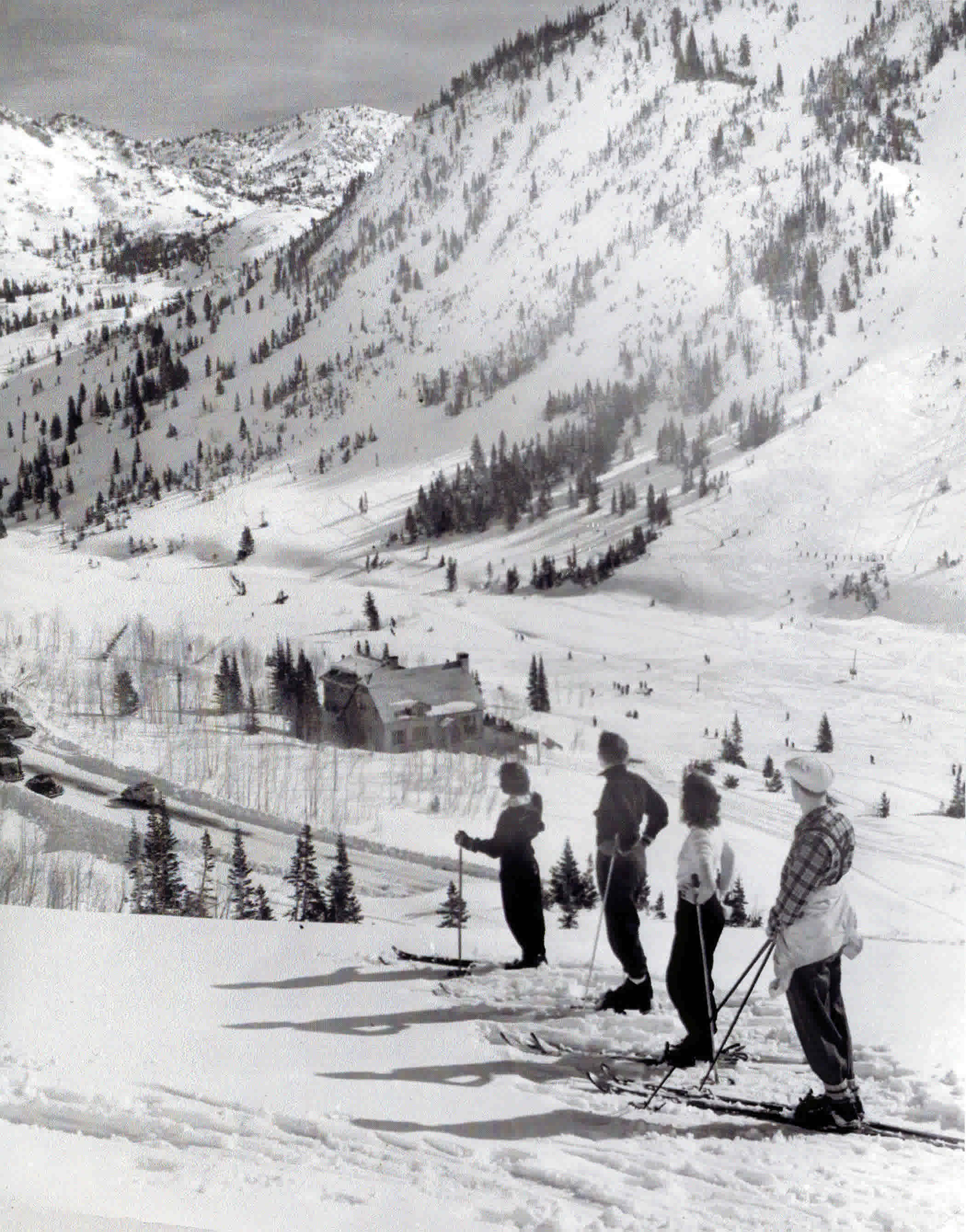 The Denver and Rio Grande Railroad—in the interest of stimulating ski tourism—donates $25,000 for construction of the Alta Lodge, the ski area’s first overnight accommodation. Although only partially completed, the lodge opened to serve the public during the winter of 1941-42, operating under a lease to J. Laughlin.
The Denver and Rio Grande Railroad—in the interest of stimulating ski tourism—donates $25,000 for construction of the Alta Lodge, the ski area’s first overnight accommodation. Although only partially completed, the lodge opened to serve the public during the winter of 1941-42, operating under a lease to J. Laughlin.
- Barge lift is disassembled, deemed ineffective for transporting skiers.
1942
503rd Parachute Battalion trains at Alta
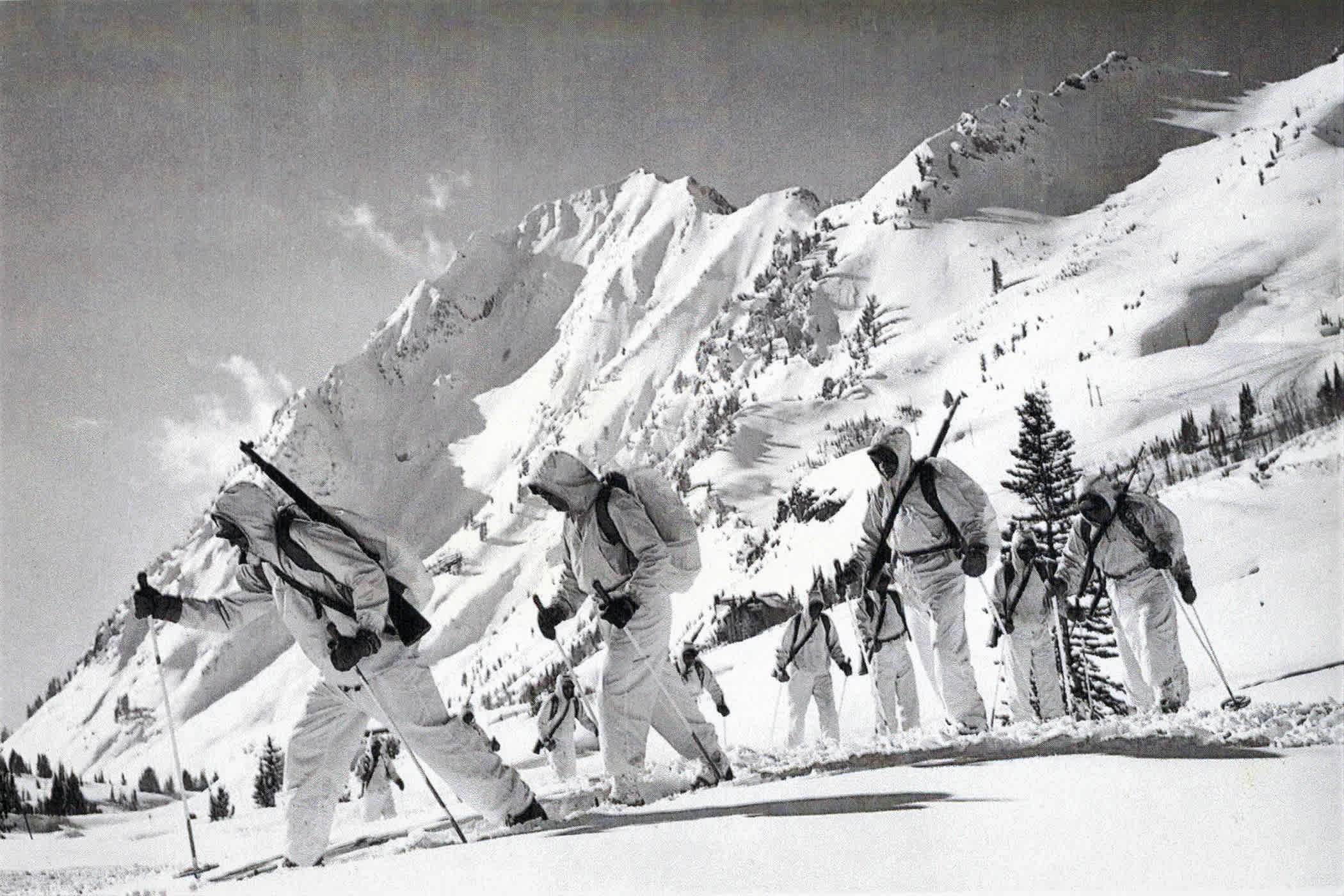 Company B of the 503rd Parachute Battalion—a predecessor to the 10th Mountain Division—trained for World War II on the slopes of Alta under Dick Durrance.
Company B of the 503rd Parachute Battalion—a predecessor to the 10th Mountain Division—trained for World War II on the slopes of Alta under Dick Durrance.
- Friedl Pfeifer was named Alta’s third Ski School Director.
- Lucky Boy lift is constructed a bit above and to the north of Snake Pit.
- Alta Ski Patrol is formed.
1943
Fred Speyer named the first General Manager
Fred Speyer is named General Manager of Alta Ski Lifts under WSA.
- Lucky Boy lift was destroyed by an avalanche.
1944
Rustler lift opens
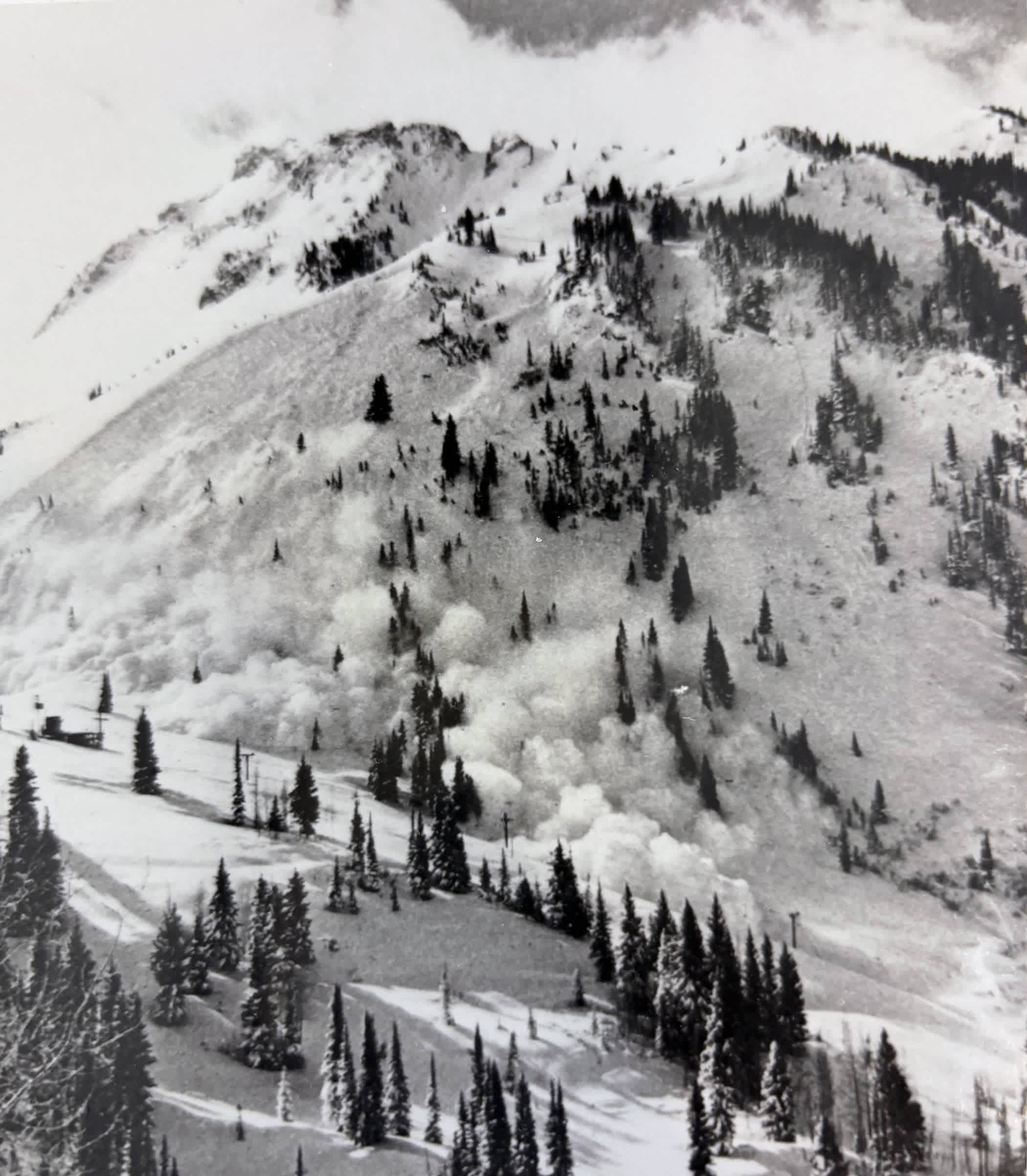
The Forest Service issues a permit for construction of the Rustler lift—a J-bar lift that was instead built as a single chair using the remnants of the unlucky Lucky Boy lift, destroyed by an avalanche the year prior.
1945
Ski Aces filmed at Alta
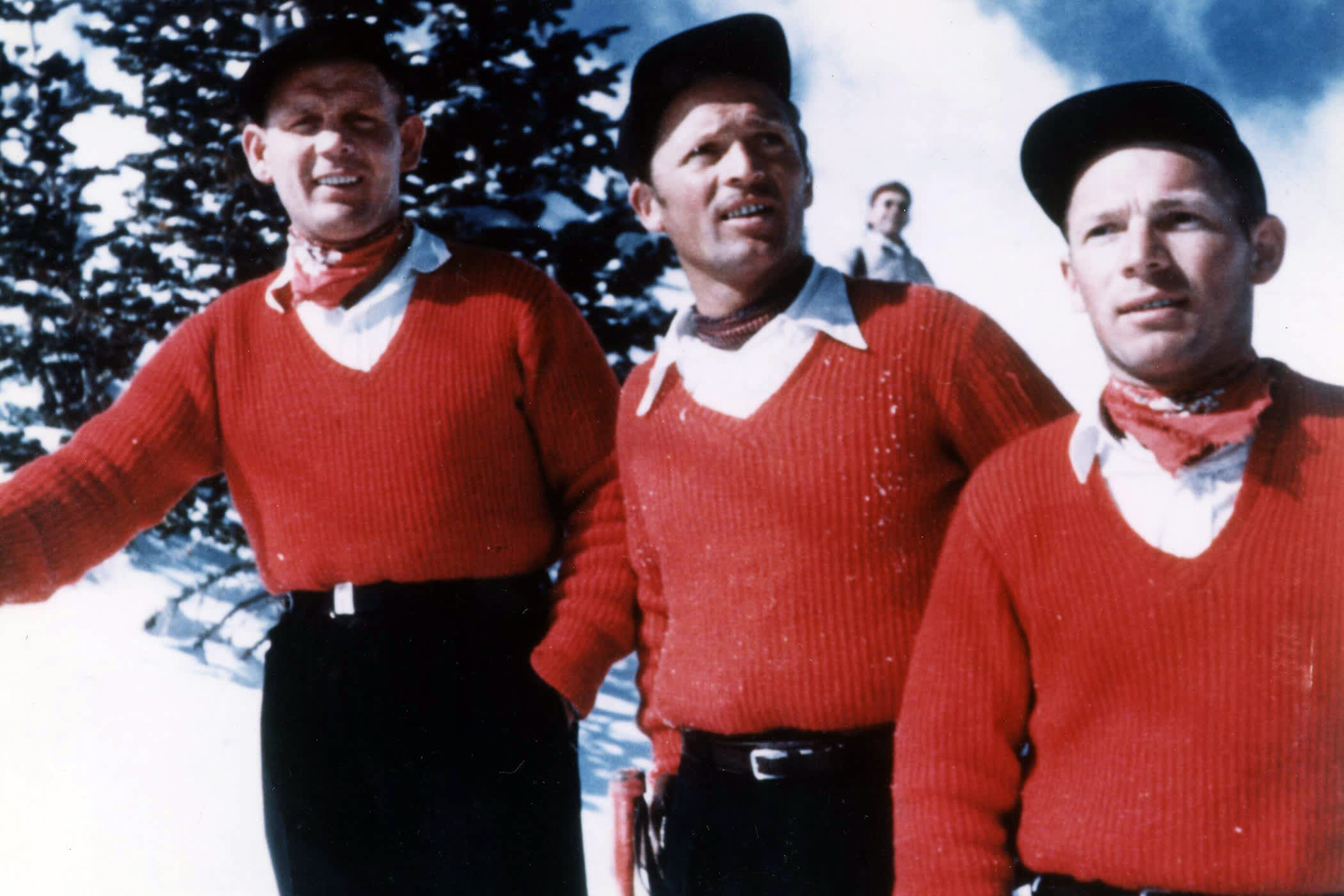
Twentieth Century Fox produced one of the first promotional ski films, featuring the skiing of the Engen brothers—Alf, Sverre and Corey.
1947
Rustler Lodge opens
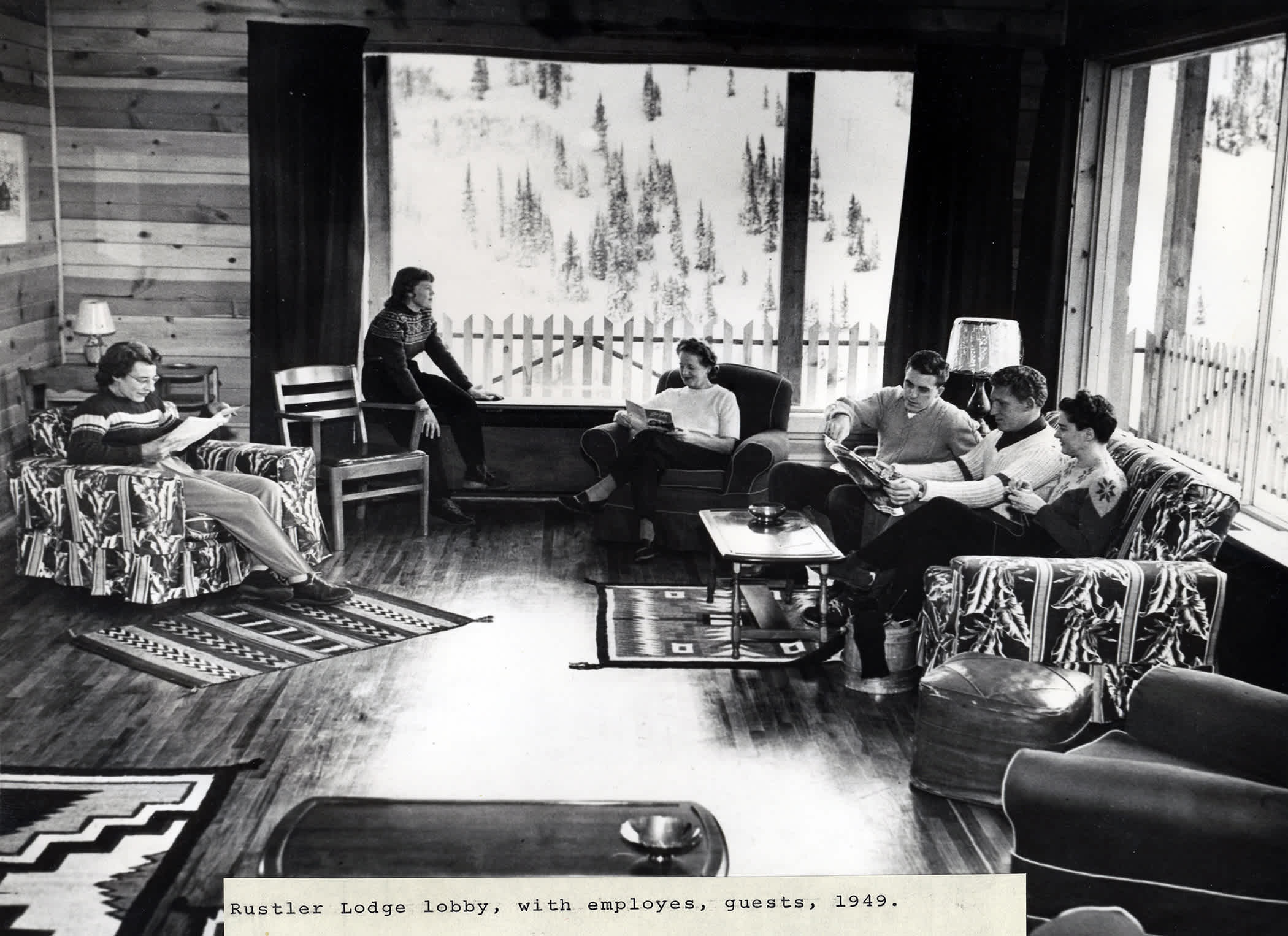
The Rustler Lodge opens—the lodge was built for $100,000
- The Landes Memorial Jump Hill is built to accommodate the growing sport of Gelande ski jumping.
- Alta hosts the United States National Slalom Championships
1948
Peruvian Lodge opens
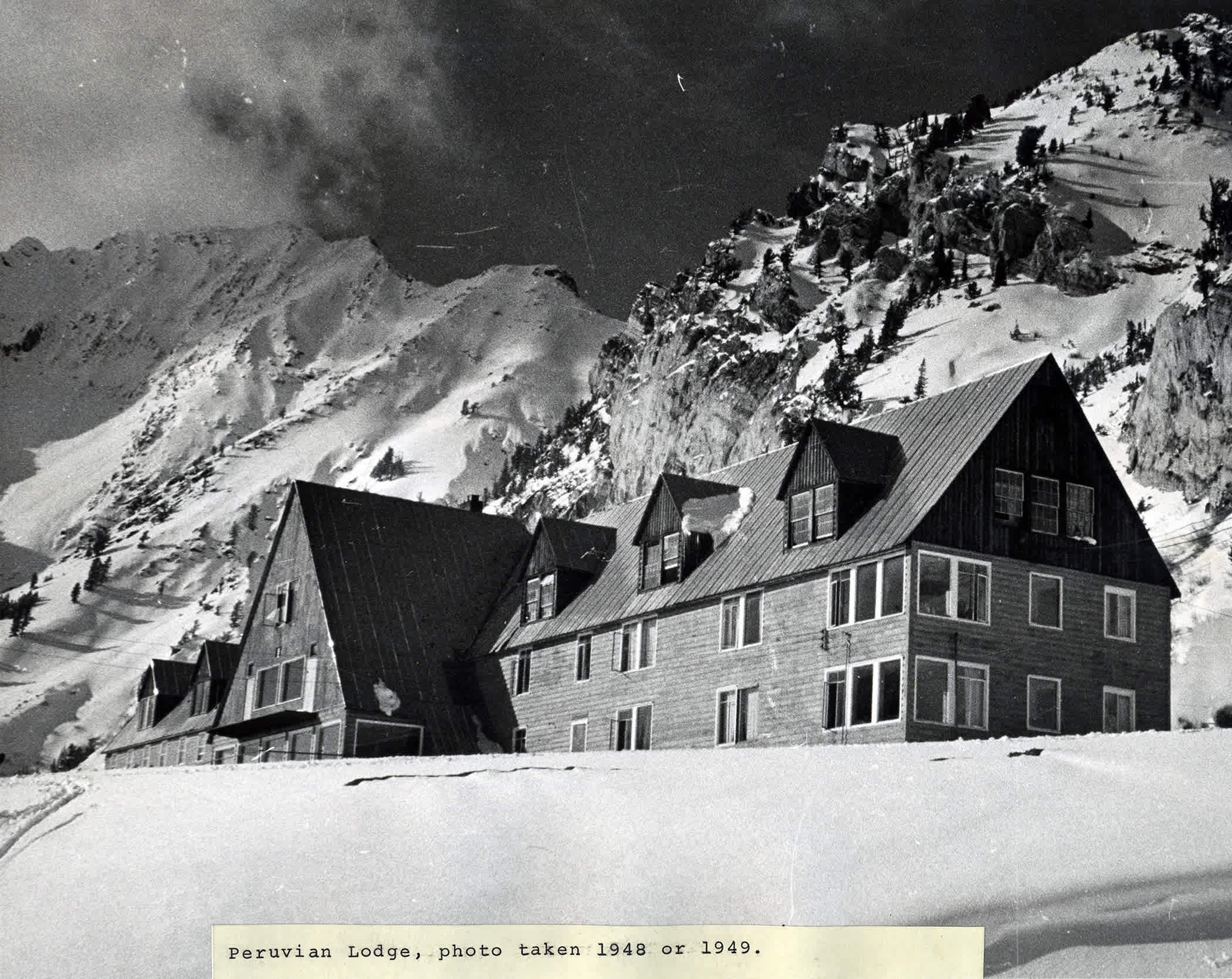 WWII army nurse barracks were disassembled in Brigham City into four parts and hauled up Little Cottonwood Canyon to be pieced together into the Alta Peruvian Lodge, operated by Edwin Gibbs.
WWII army nurse barracks were disassembled in Brigham City into four parts and hauled up Little Cottonwood Canyon to be pieced together into the Alta Peruvian Lodge, operated by Edwin Gibbs.
- Alta constructed two of the first backcountry ski huts in Utah near Germania Pass and Point Supreme.
1949
Introduction of Military Artillery
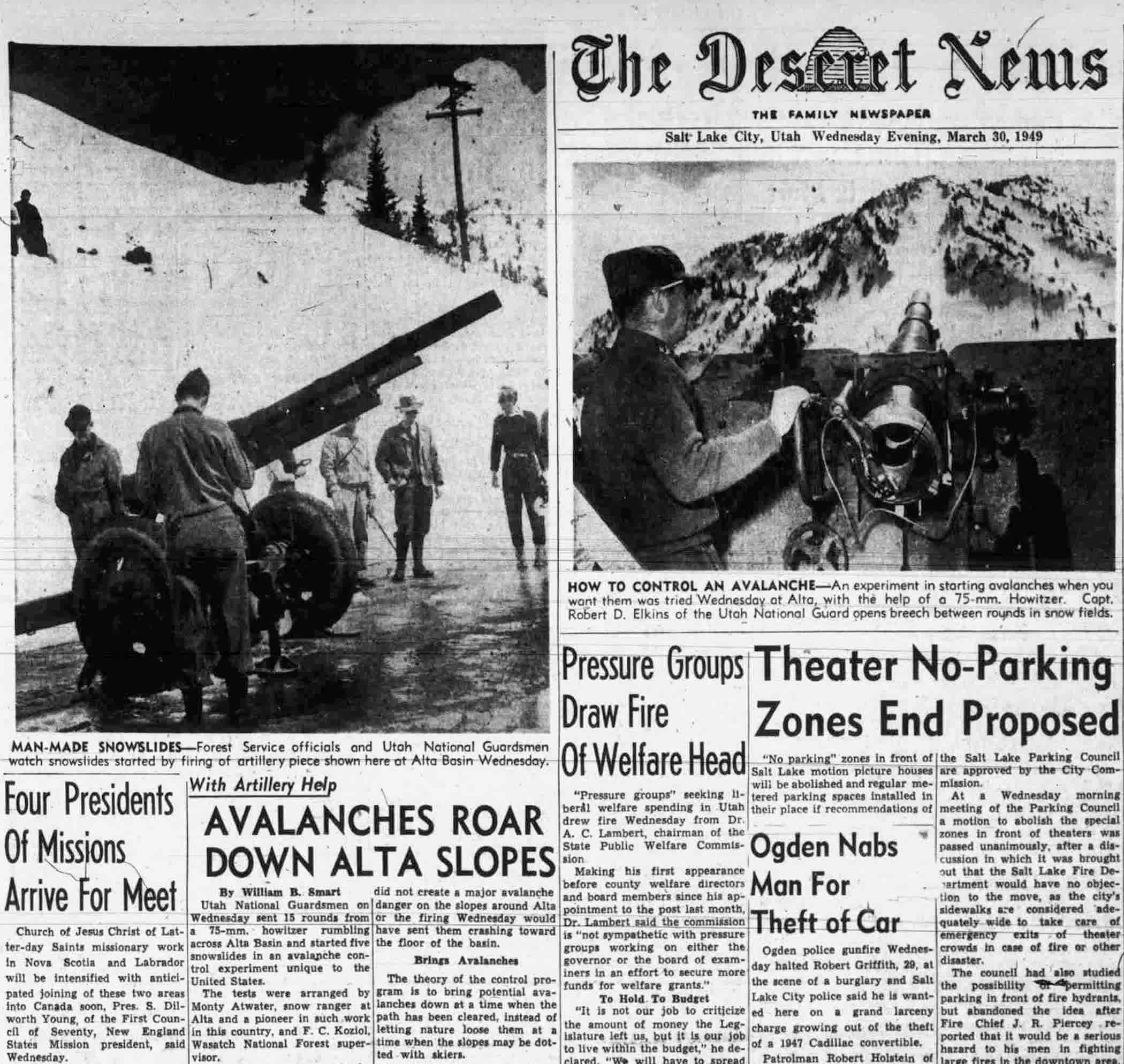 Monty Atwater—with approval from the USFS—convinces the Utah National Guard to test fire a howitzer at Alta in late March, forever changing avalanche mitigation in North America. Snow science pioneers at Alta continue to innovate and make many discoveries.
Monty Atwater—with approval from the USFS—convinces the Utah National Guard to test fire a howitzer at Alta in late March, forever changing avalanche mitigation in North America. Snow science pioneers at Alta continue to innovate and make many discoveries.
- Collins lift upgraded to steel towers.
1951
Professional Ski Instructors of America (PSIA) founded at Alta
Outline of Ski Teaching Methods, which was the first complete ski instructors' manual written and distributed on a national level throughout America.
- On January 6, 1951, Alta hosted the United States National Giant Slalom.
- Snowpine Lodge rope tow and Landis Jump Hill tow are installed.
1952
Birthplace of Avalanche Mitigation
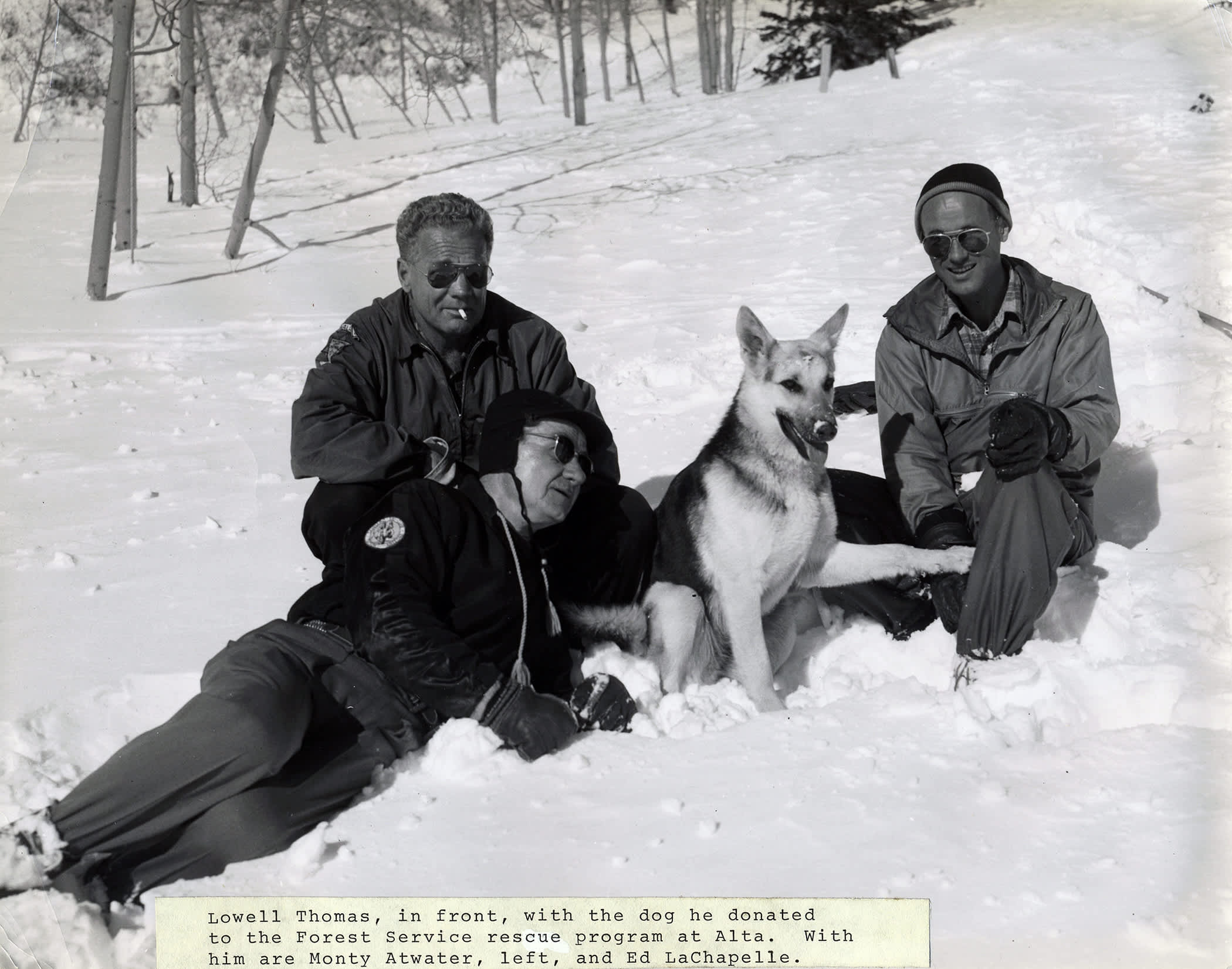
Monty Atwater gains permission to fire a WW1 French 75mm howitzer for avalanche control work without requiring a Utah National Guard member.
- Ed LaChapelle introduces Cola, a German Shepherd and the first dog used in locating avalanche victims in the USA.
1954
Germania lift opens
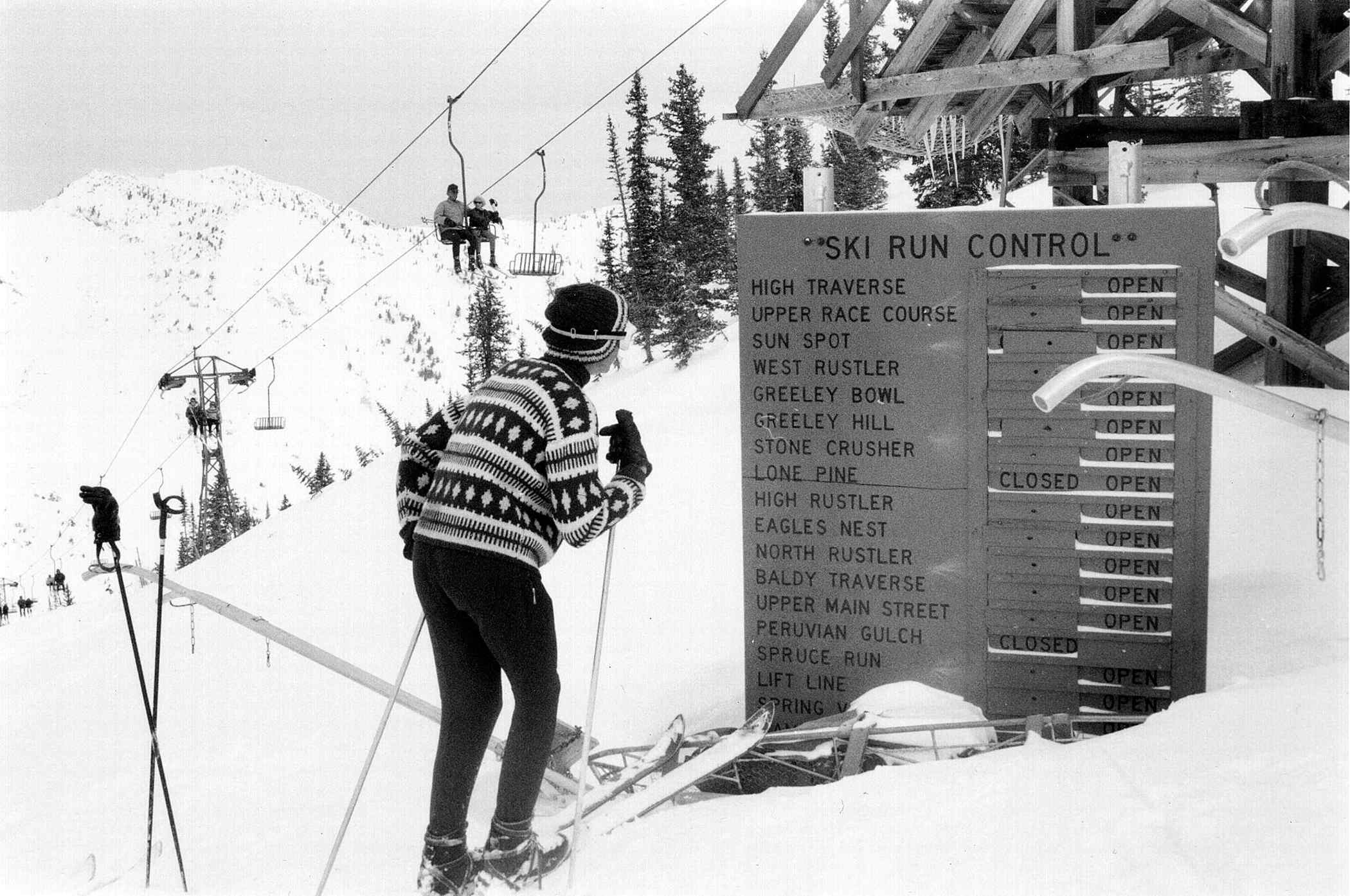 Alta's first double-chair lift, a Heron Engineering lift, carries skiers to the top of Collins Gulch from the top of Collins lift.
Alta's first double-chair lift, a Heron Engineering lift, carries skiers to the top of Collins Gulch from the top of Collins lift.
- A larger mid-mountain restaurant was constructed near the original Watson Shelter to replace the aging building.
- The top terminal of the Peruvian lift catches fire, the decision is made to decommission the lift.
1958
Chic Morton named Alta Ski Lifts second General Manager
Fred Speyer retired as the first Alta General Manager and Chic Morton was named to replace him.
1959
Wildcat lift opens
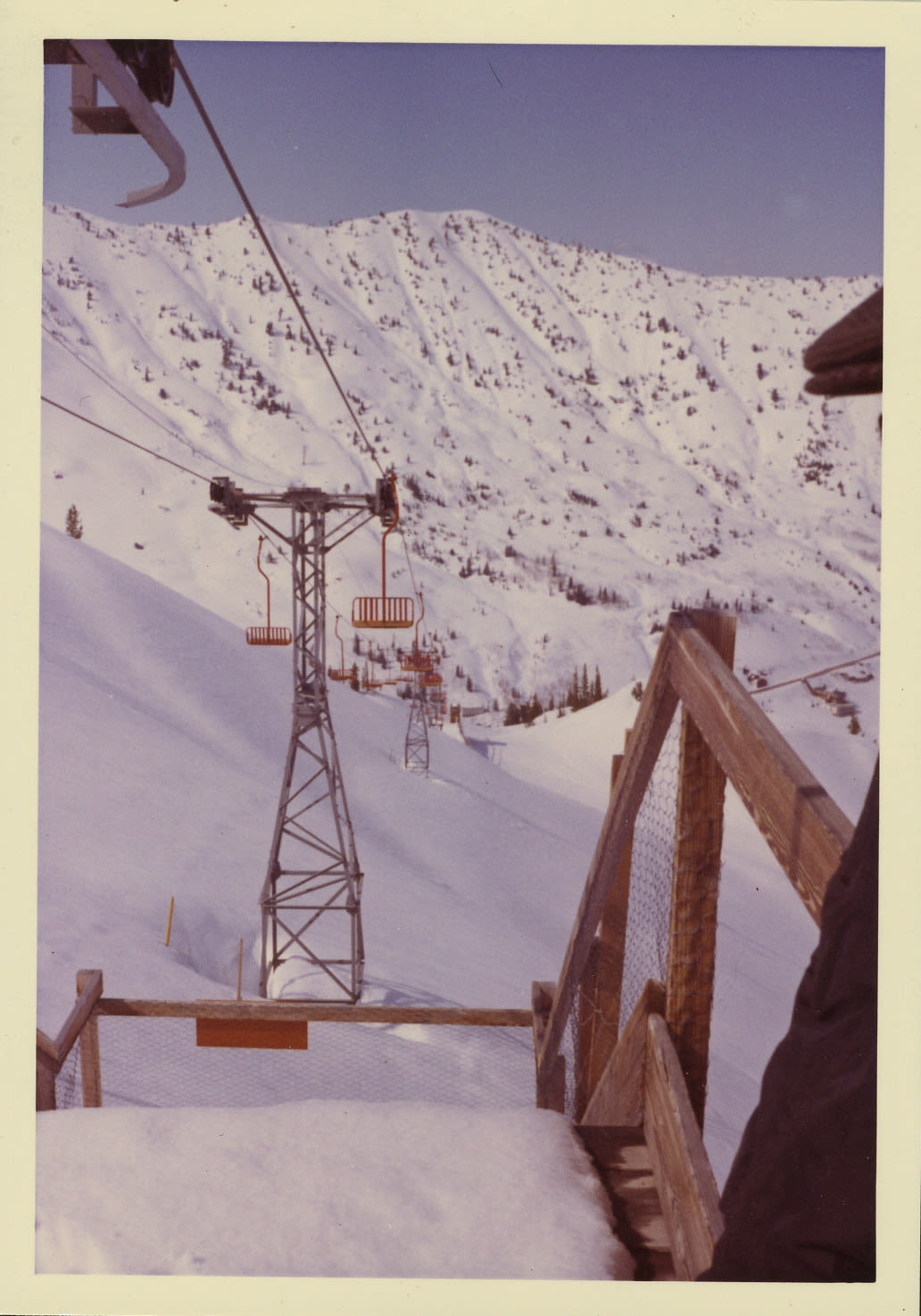
The Wildcat double-chair lift, a Heron Engineering lift, opens to the public.
- Bill Levitt purchased the Alta Lodge from J. Laughlin.
1960
Alta hosts National Championships again
Alta hosted the United States National Downhill, Giant Slalom, Slalom, and Combined Championships.
1962
Goldminer’s Daughter Lodge opens
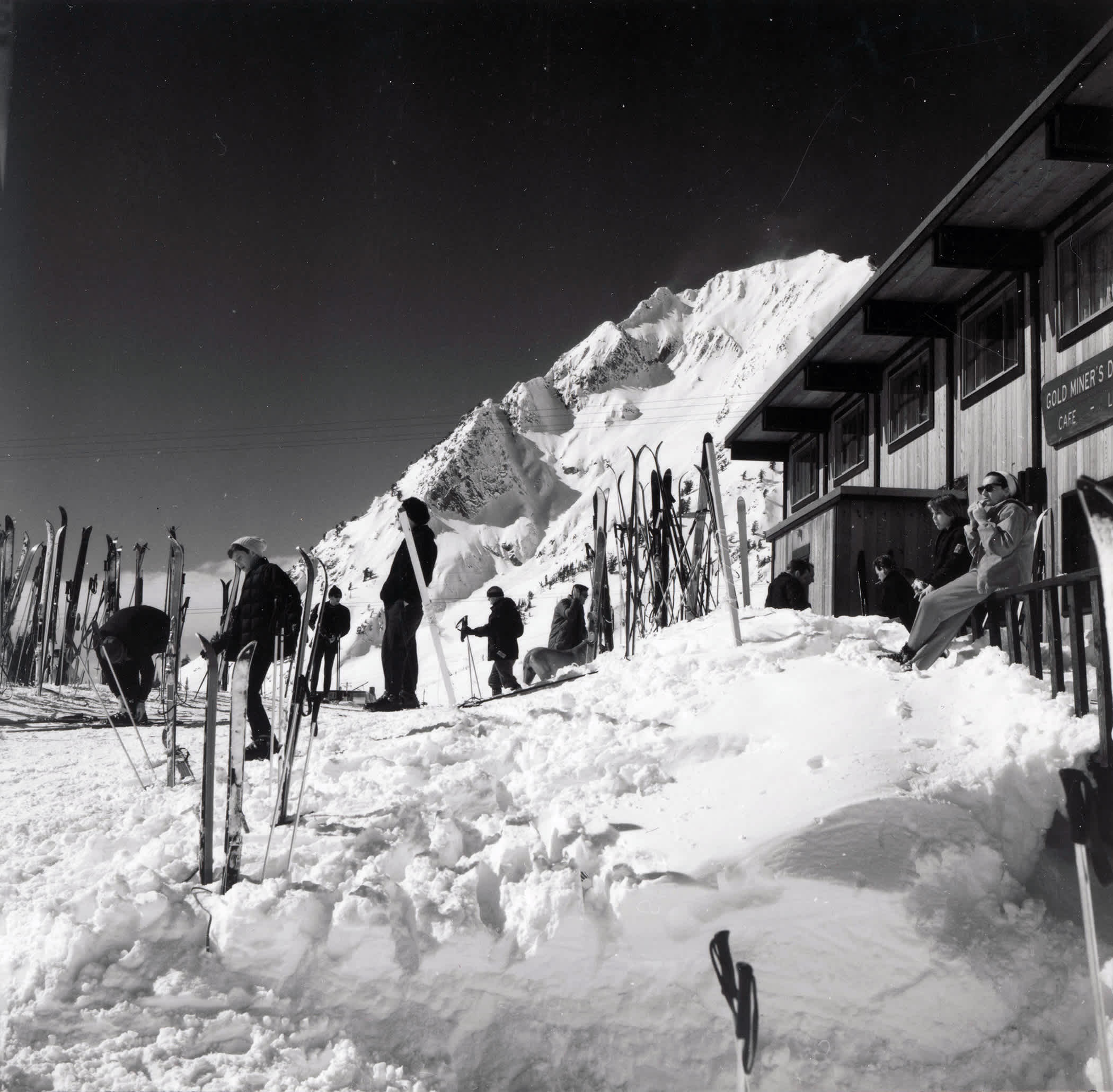
Jim and Alphreda Shane open the Goldminer’s Daughter Lodge at the base of Collins and Wildcat lifts in the Collins base area.
1963
Inaugural Gelande Competition at Alta
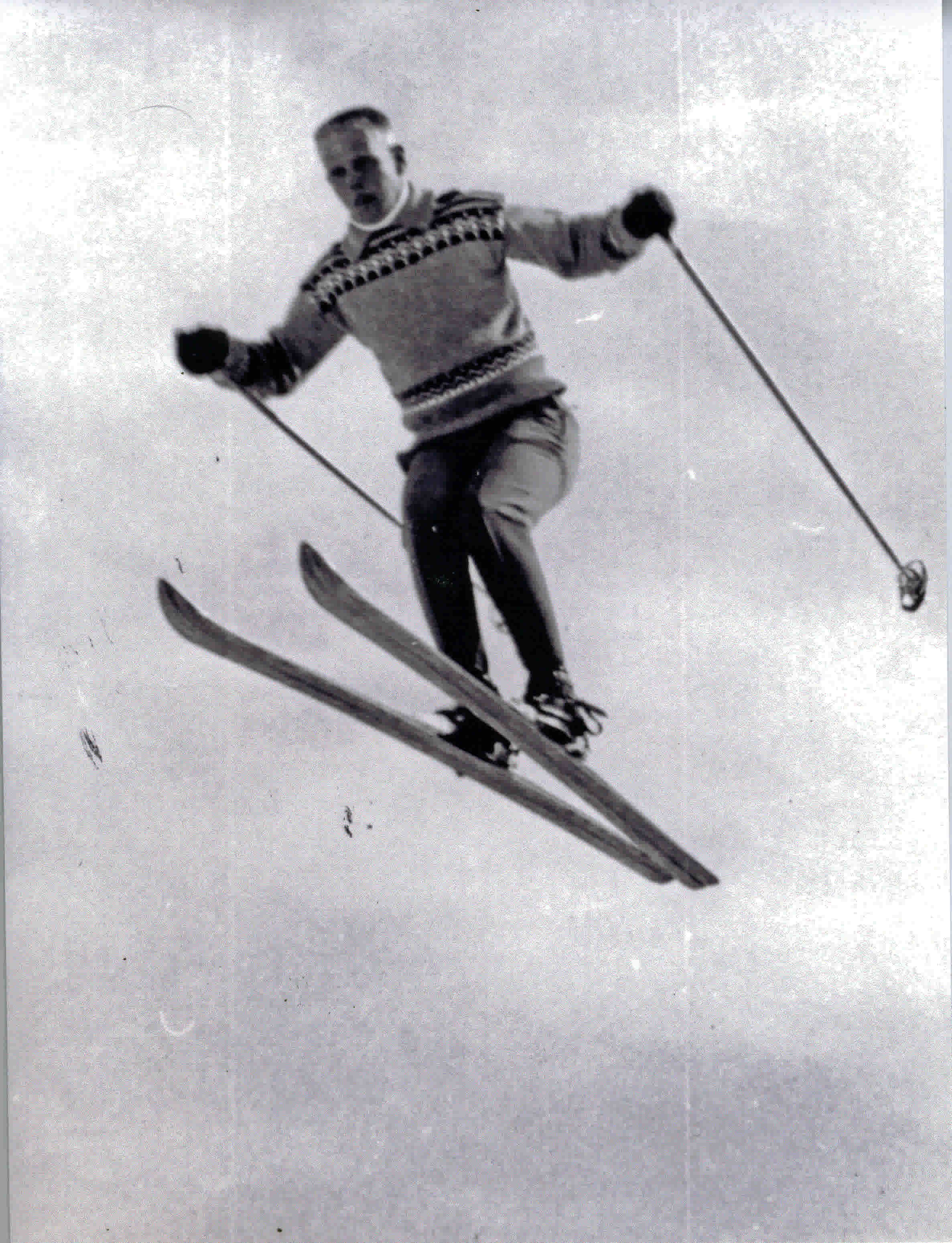
America’s first Gelande competition is held at Alta Ski Area in April 1963—featuring Stein Erickson, Pepi Steigler and Junior Bonous. Alan Engen, son of Alf, wins the competition. The first National competition would be held in 1965.
- Albion lift opens—a Heron Engineering fixed-grip double in Albion Basin.
1966
Lift Hof built
Alta's Lift Hof administrative building is constructed just west of the Wildcat lift base terminal, with offices, ski patrol room, public restrooms and quarters for married employees.
1967
Sugarloaf lift opens
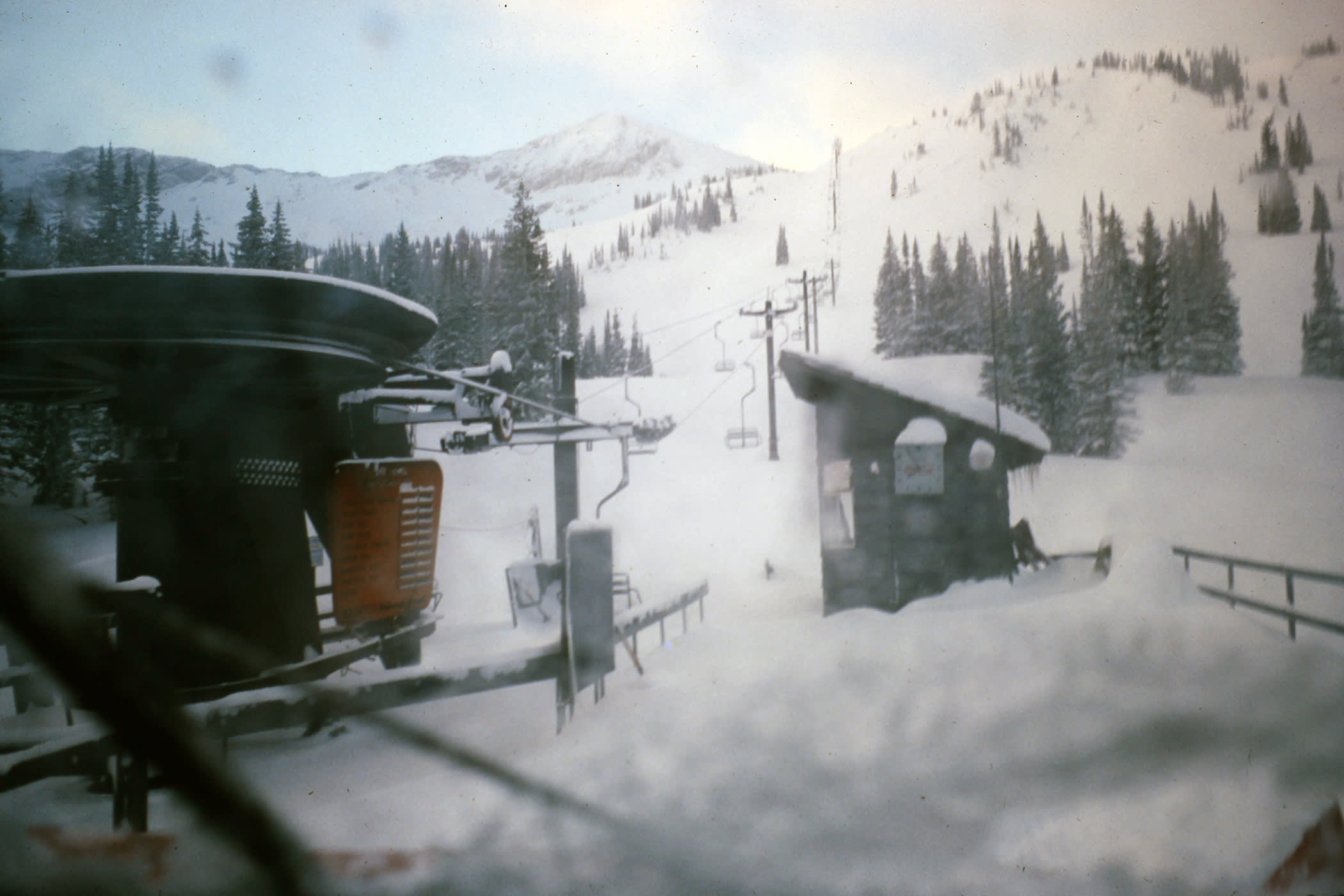
The Sugarloaf double-chair lift, from Hall Ski-Lift Company, opens and skiers enjoy new terrain at Alta.
1968
Alpenglow mid-mountain lodge opens
Construction of Alpenglow is completed as a public shelter with a cafeteria, sundeck and restrooms to serve Sugarloaf and Albion Areas.
1970
Sunnyside lift opens
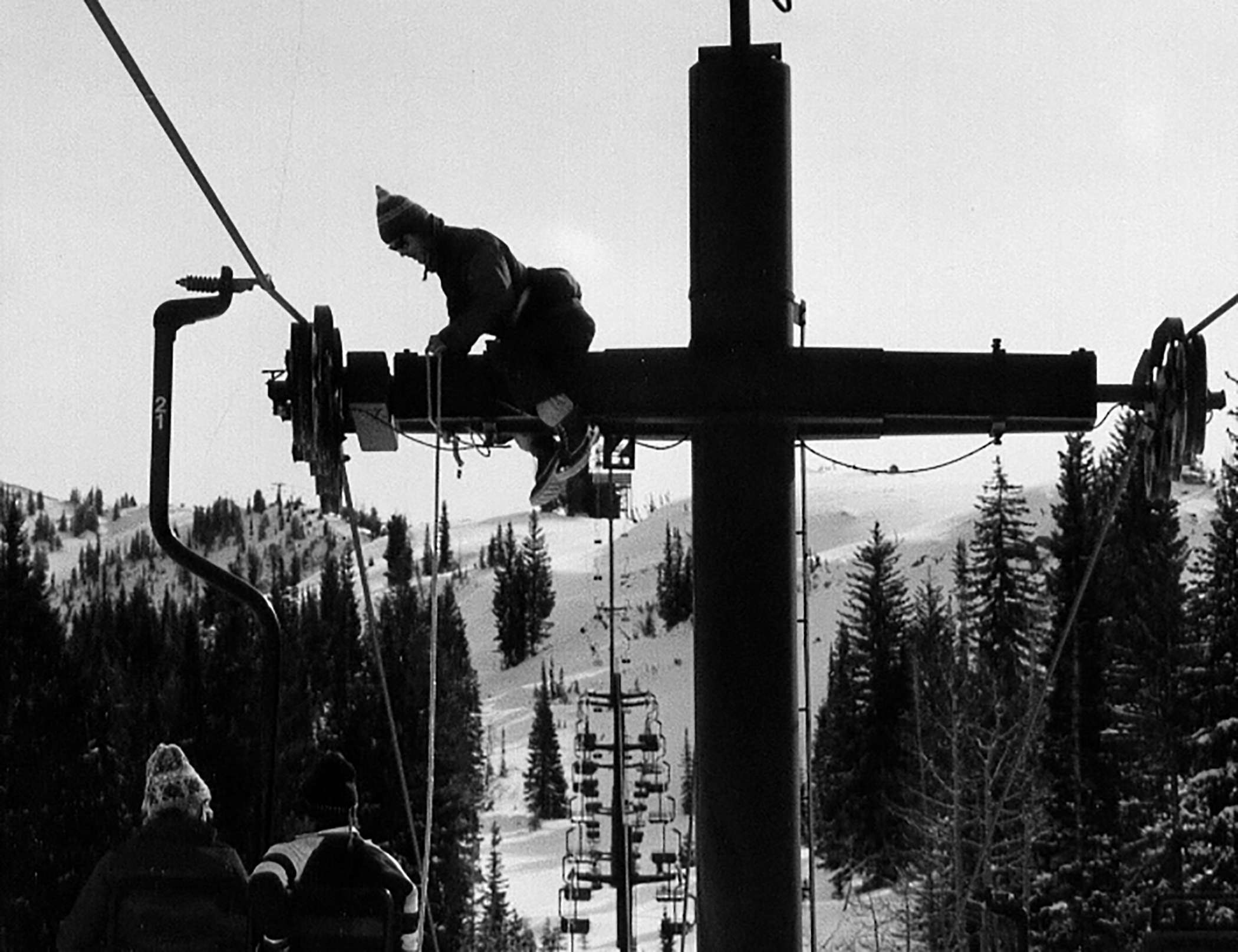
The Sunnyside double-chair lift, from Hall Ski-Lift Company, opens in the Albion Basin, carrying skiers closer to Sugarloaf lift and Alpenglow shelter.
- Town of Alta was incorporated.
1971
Snowbird opens
In December 1971, Snowbird opened next door to Alta Ski Area, bringing two world-class ski areas to Little Cottonwood Canyon.
1973
Collins lift upgraded
The original Collins single-chair lift is retired and the Collins lift is upgraded to a double-chair lift from Yan Lift.
1974
Germania lift realigned
The Germania lift is upgraded to a Yan Lift and realigned from Fred’s Slot to the current Collins lift line.
1976
Albion lift upgraded
The Albion lift receives a major overhaul to a Yan lift with the bottom-drive motor and new sheave trains.
1977
Drought delays opening
A drought delays Opening Day of the 1976–77 season until January 5th. The Alta Guard Study plot records just 315 inches of seasonal snowfall.
1980
Alta Ski Patrol's first Avalanche Dog
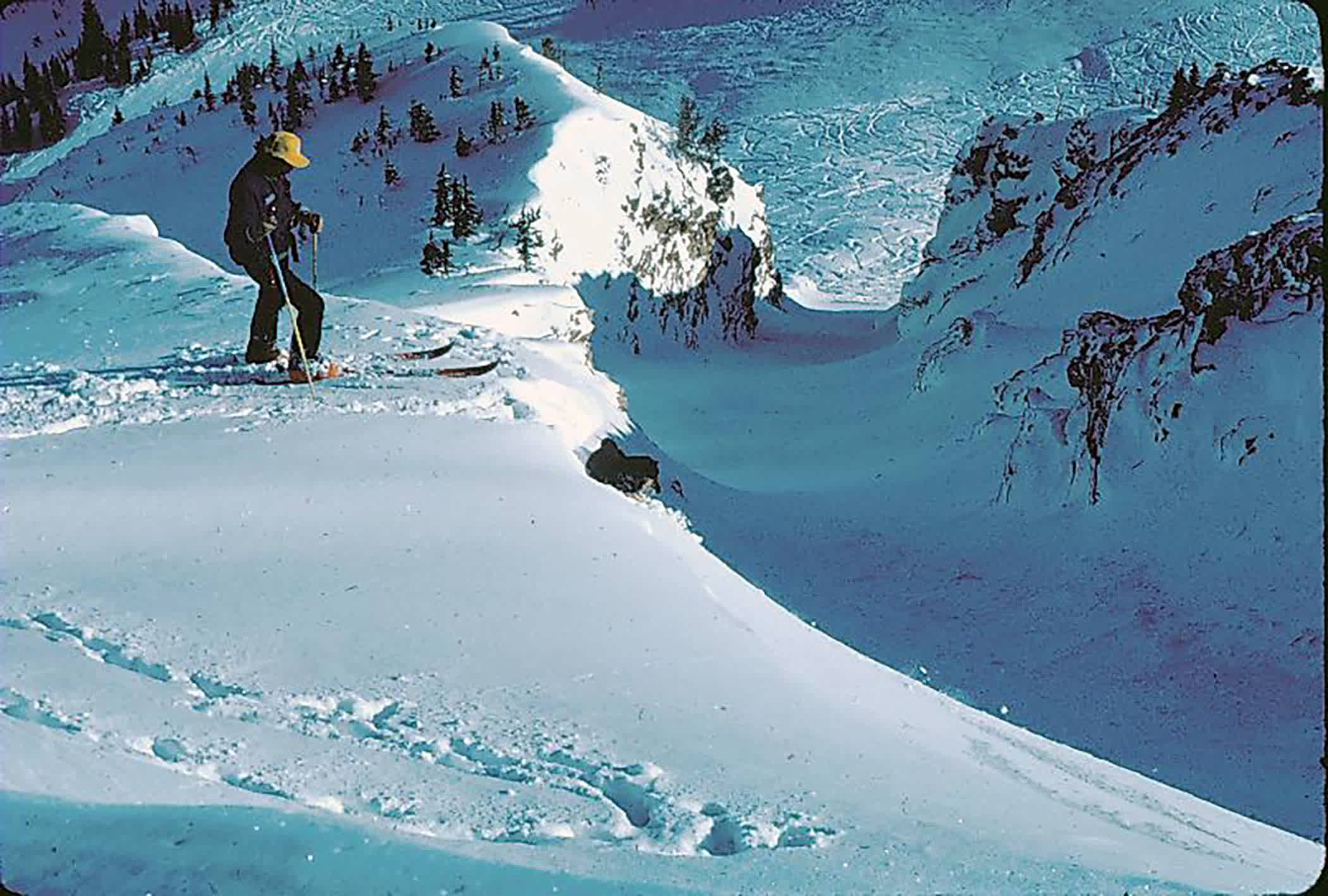
Alta Ski Patroller Dan O'Connor trains a female pup to locate buried skiers under the snow, launching the avalanche dog program at Alta Ski Area.
1981
Supreme and Cecret lifts open
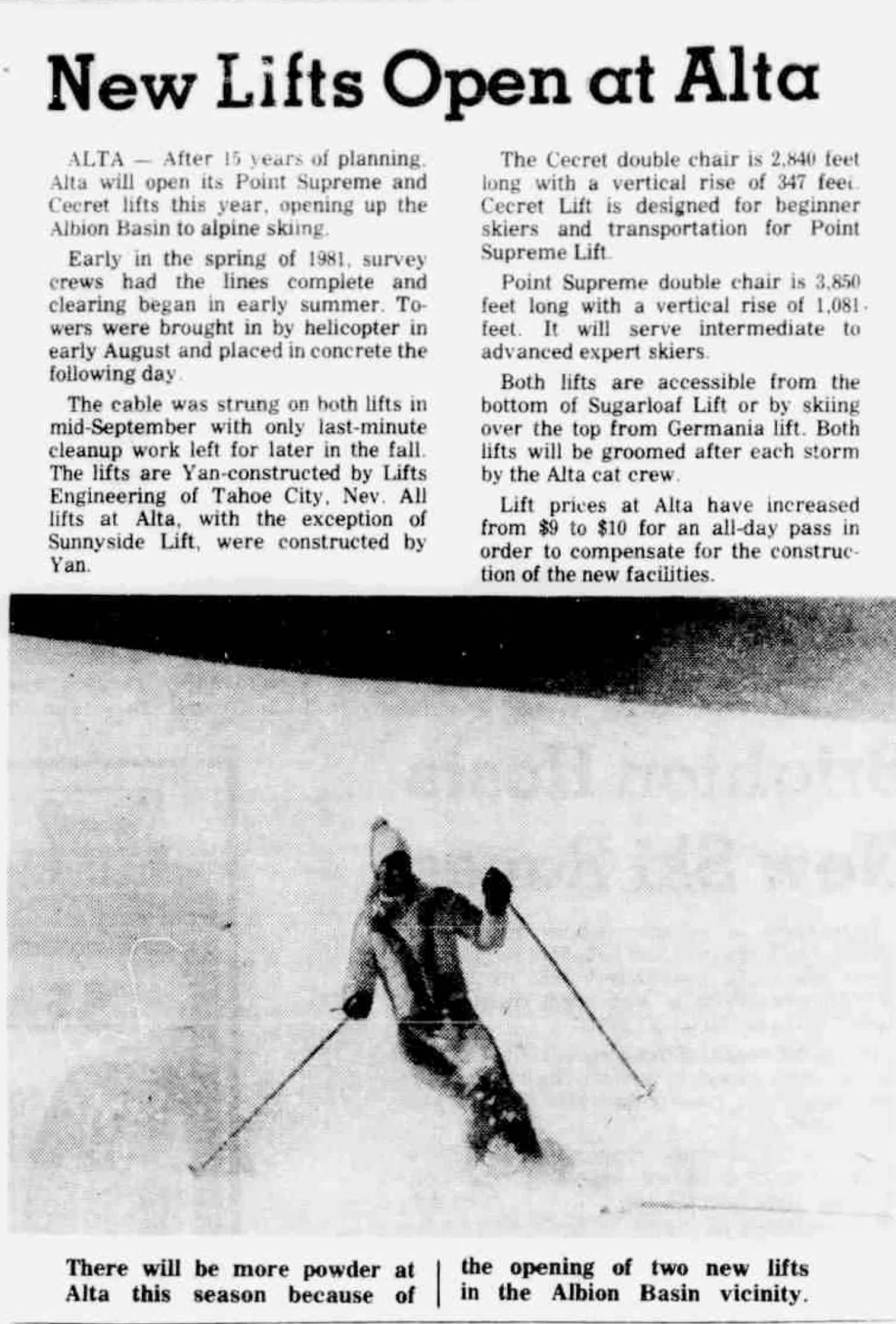
Supreme and Cecret lifts—two new fixed-grip double-chair lifts from Yan—open to Alta skiers, greatly expanding terrain to Point Supreme and Catherine’s Area.
1982
748 inches of snow
The 1981–82 season delivered 748 inches of snow—a seasonal snowfall record that would stand for 40 years.
1983
Albion Ticket Office opens
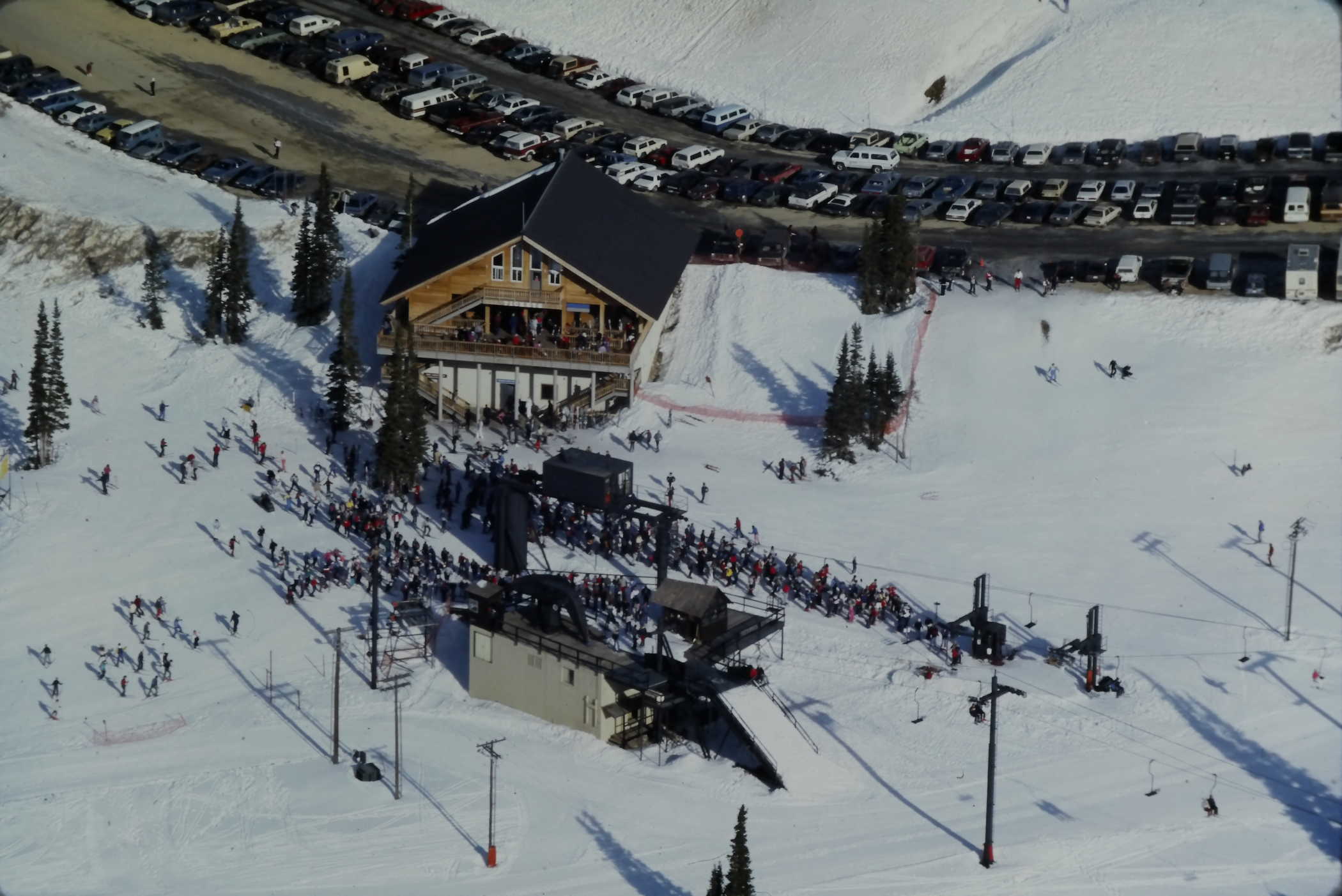
Albion Ticket Office is built, replacing the old sales shack.
1986
Albion Day Lodge opens
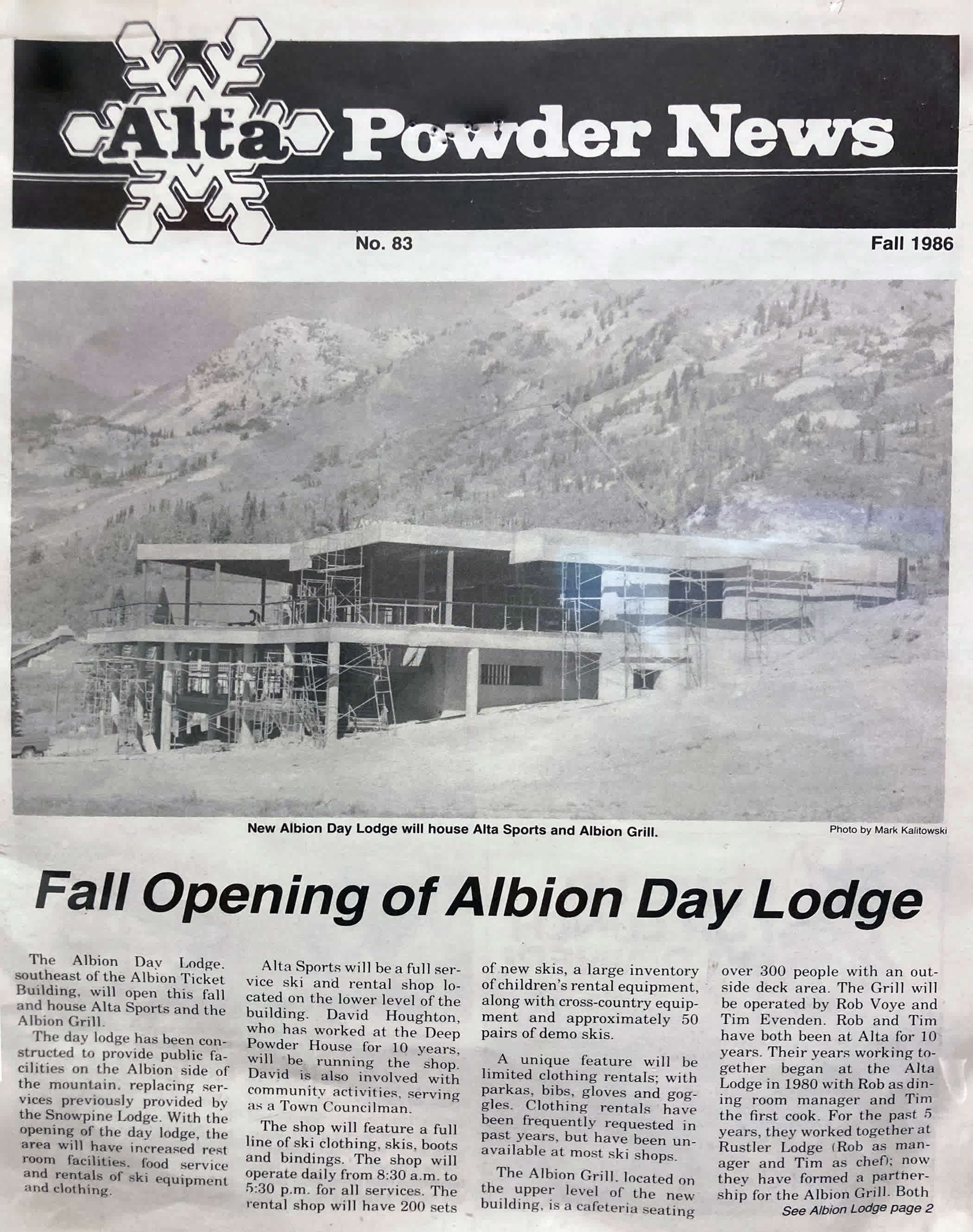
The Albion Day Lodge opened in 1986 in the Albion base area.
1988
Onno Wieringa named Alta’s third General Manager
Chic Morton retires and Onno Wieringa is named Alta Ski Area’s third general manager.
- Snowmaking is introduced to Alta.
1991
Germania lift upgraded
The Germania lift received an overhaul and was upgraded to a triple-chair lift from Yan Lifts.
- Wildcat midway station is removed.
1992
Transfer Tow opens
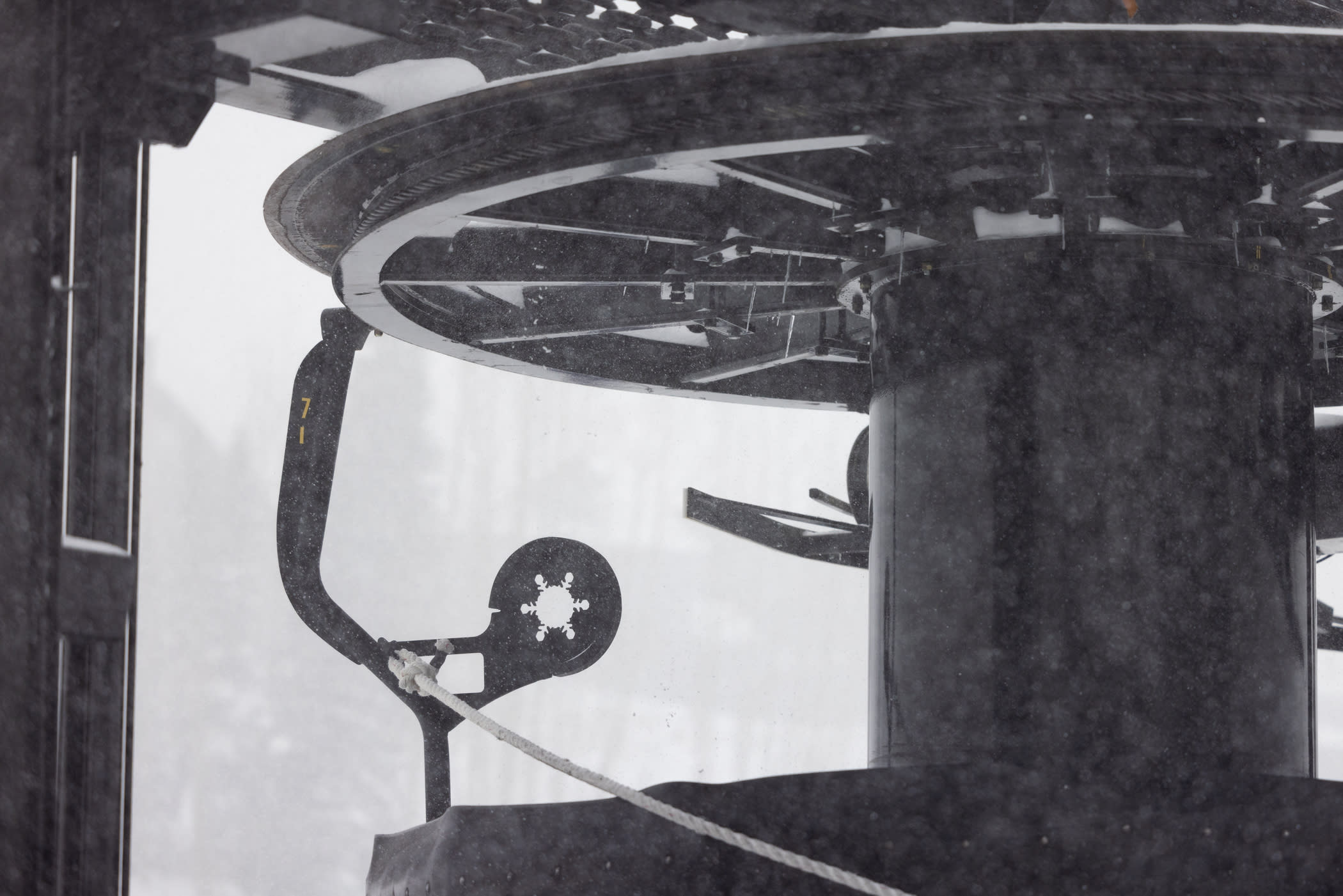
Transfer Tow is built, a new Yan Lifts surface tow connects the Albion and Wildcat base areas.
- Sugarloaf lift upgraded to a triple-chair from Yan Lifts.
- The East Baldy Traverse (EBT) connects Sugarloaf to Germania Pass.
1994
24-Hour Snowfall Record
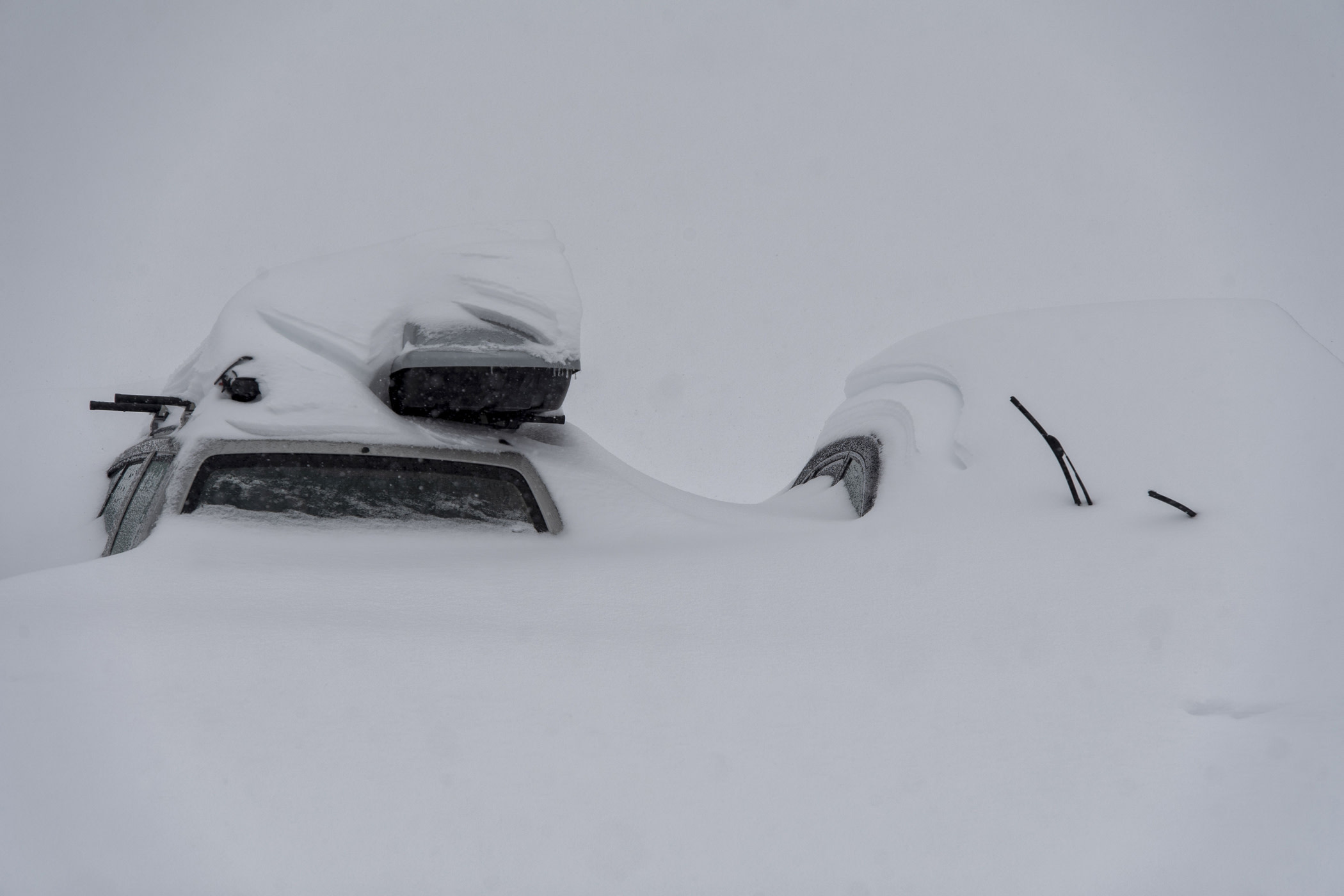
Jan 5th–6th Alta receives a record 55.5" of snow in 24 hours.
- Alpenglow is demolished and replaced by Alf’s Restaurant.
- Wildcat Ticket Office is built.
1997
Alta invests in Reforestation and Revegetation efforts
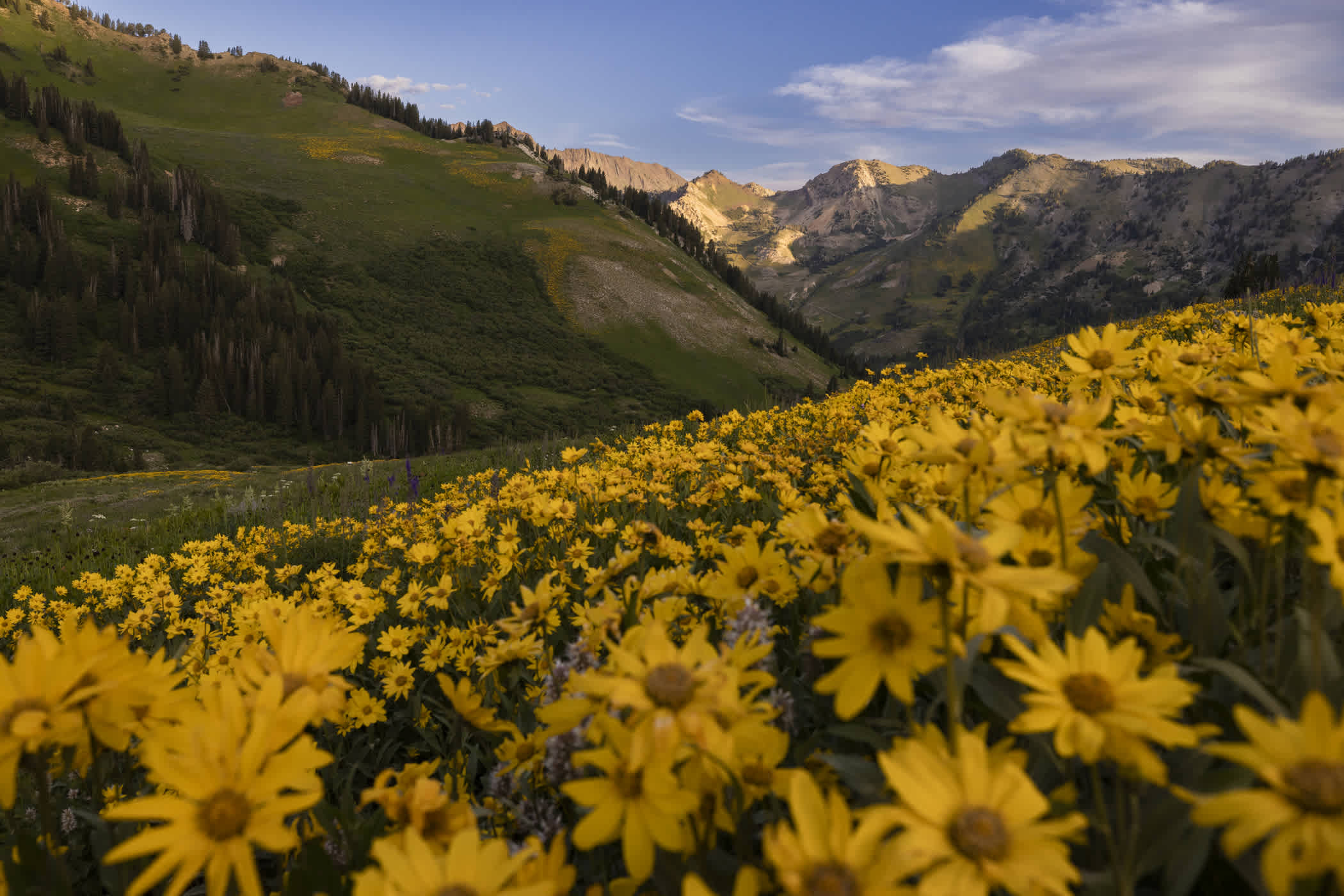
Alta’s summer employees completed work on Albion Meadows trail—a three-mile trail up to Cecret Lake. Hikers are also able to access the popular Catherine Pass and Germania Pass trails.
- Alf Engen and Chic Morton pass away within weeks of each other.
1999
Sunnyside becomes Alta’s first high-speed lift
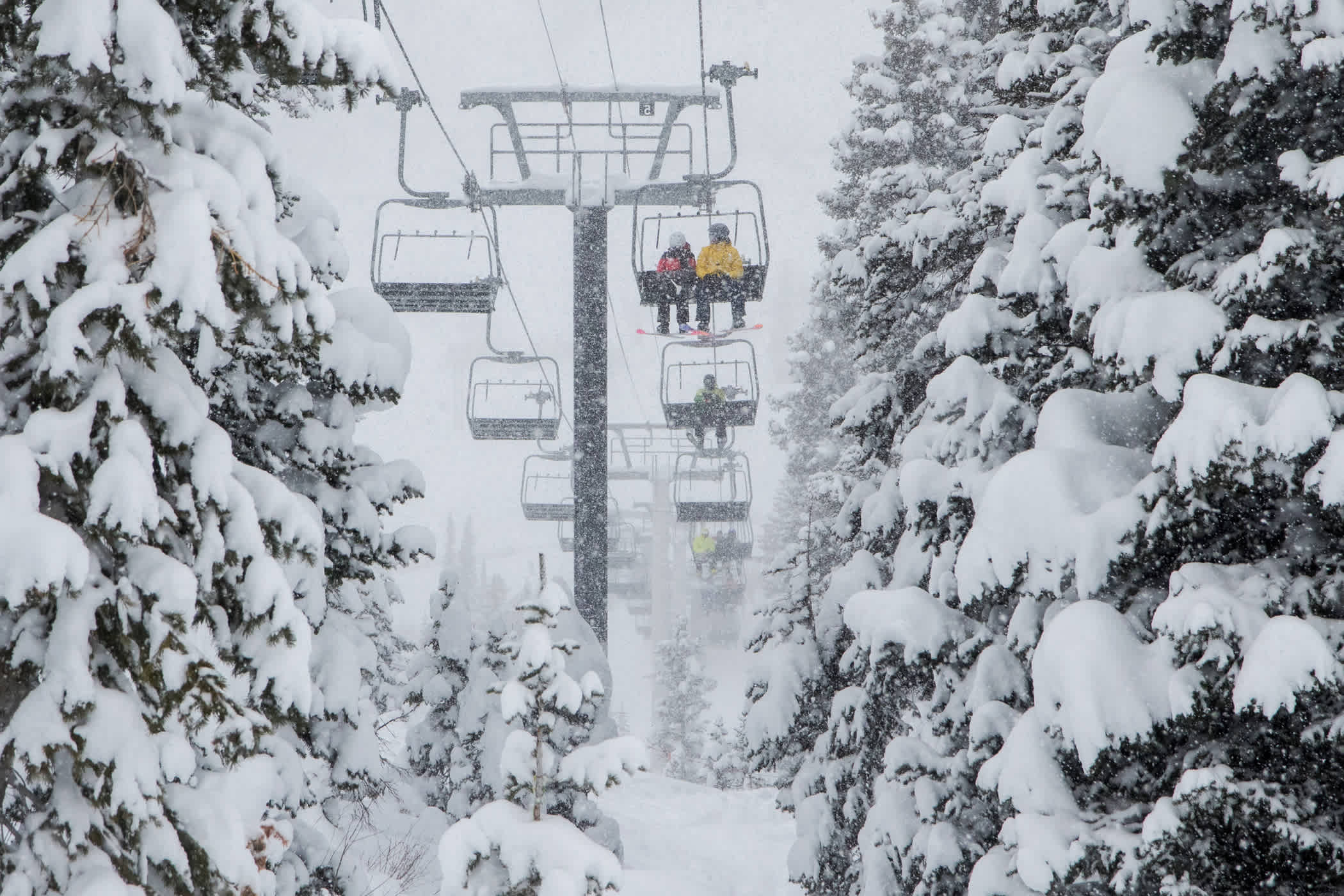
The Sunnyside lift is realigned and upgraded from a fixed-grip double-chair to a high-speed detachable triple-chair lift from Garavanta CTEC.
2001
Sugarloaf becomes a high-speed quad
The Sugarloaf lift is upgraded to a detachable high-quad lift from Garavanta CTEC—the triple chairs are moved to the Supreme lift.
2002
Alta-Bird Connection opens
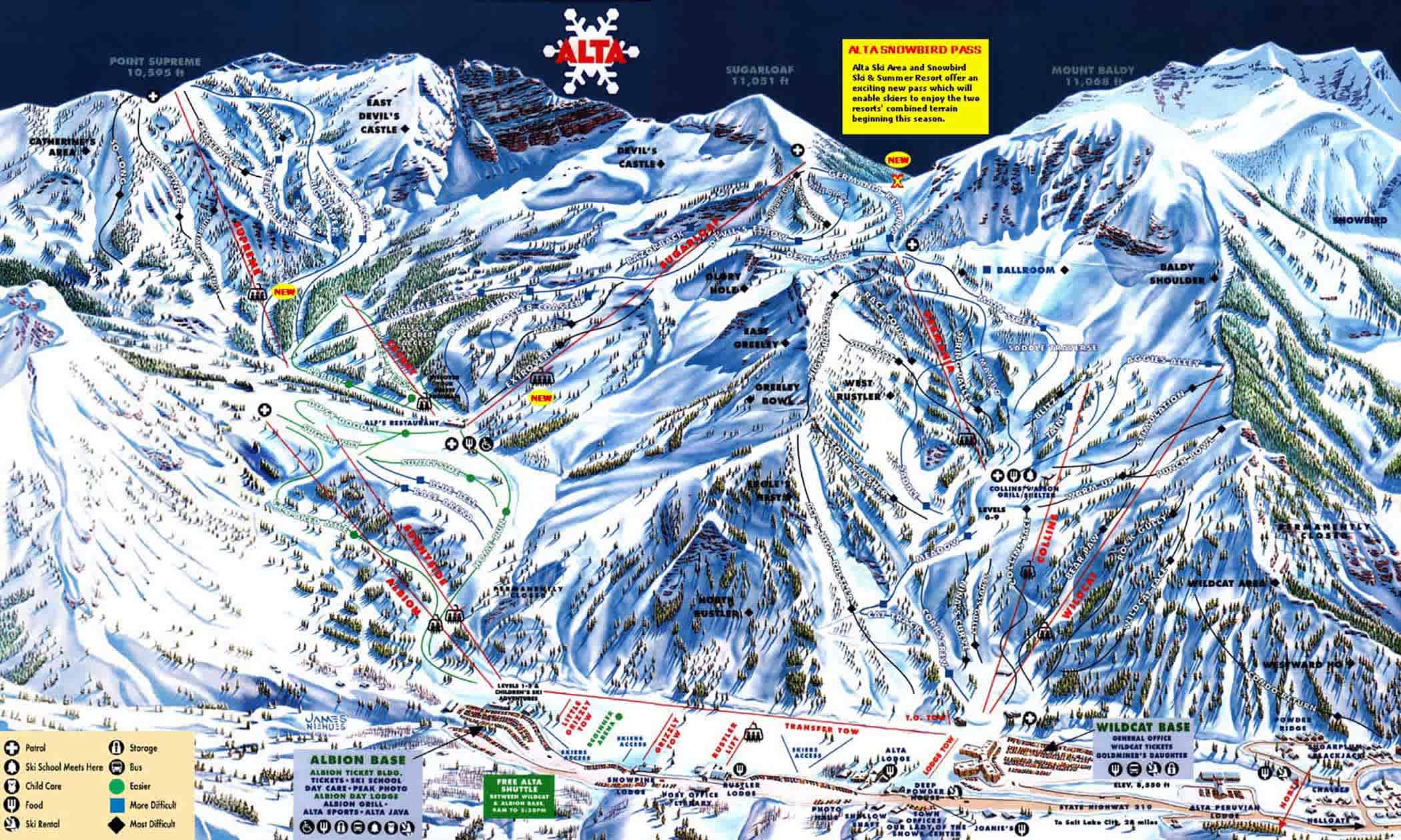
Alta Ski Area and Snowbird begin selling multi-resort season passes and lift tickets, providing access to a combined 5,114 acres.
- Supreme lift upgraded from a fixed-grip double-chair to a fixed-grip triple-chair.
2004
Collins lift receives an overhaul
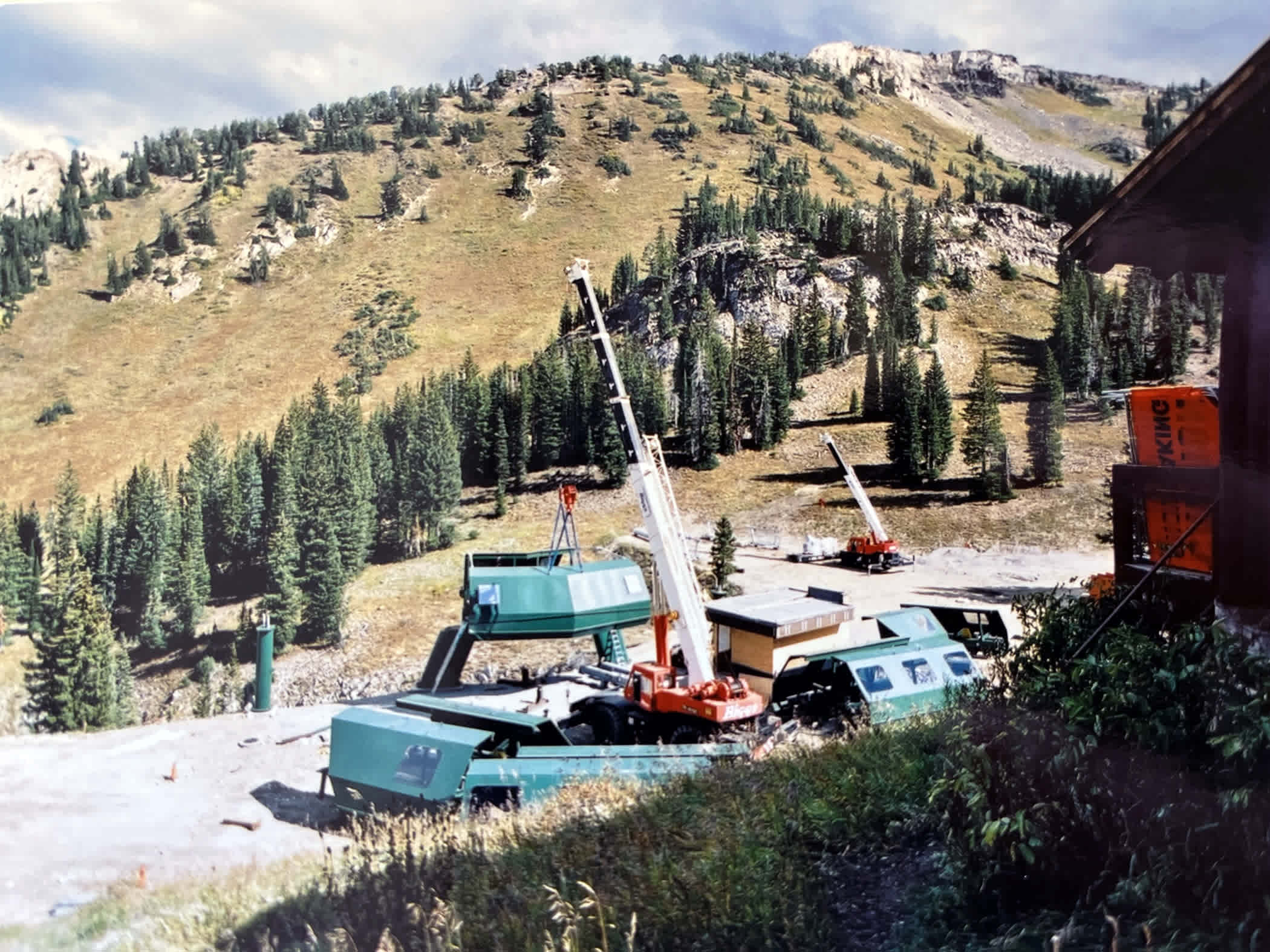
Germania & Collins lifts replaced by Collins high-speed detachable quad with a mid-mountain angle station.
- Watson Shelter is rebuilt next to the Collins angle station.
- First year of the Alta Ski Shop in the Wildcat Ticket Office.
2008
Alta Environmental Center is born
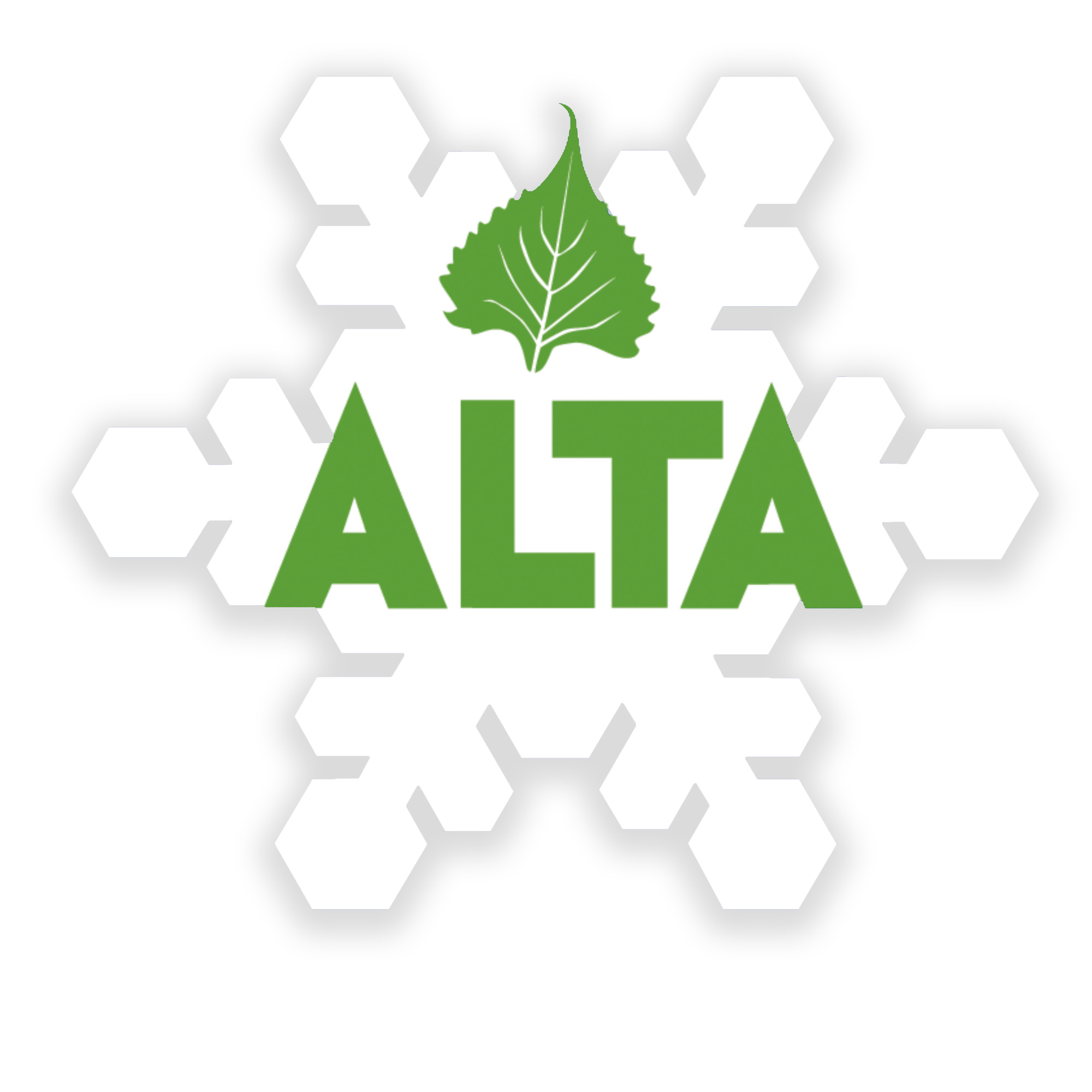
The new center begins guiding Alta Ski Area’s sustainability and stewardship efforts and looks after the natural environment in which we operate. Its mission is sustainability—to protect and improve the well-being of Alta’s environment, ski industry and community.
2012
New LEED-Certified Buckhorn Skier Services Building
Alta Ski Area remodeled the Buckhorn employee housing and administrative building and was awarded LEED Silver Certification by the Green Building Certification Institute.
- Alta becomes a founding member of Mountain Collective.
2013
Golden Eagle Award for Overall Environmental Excellence
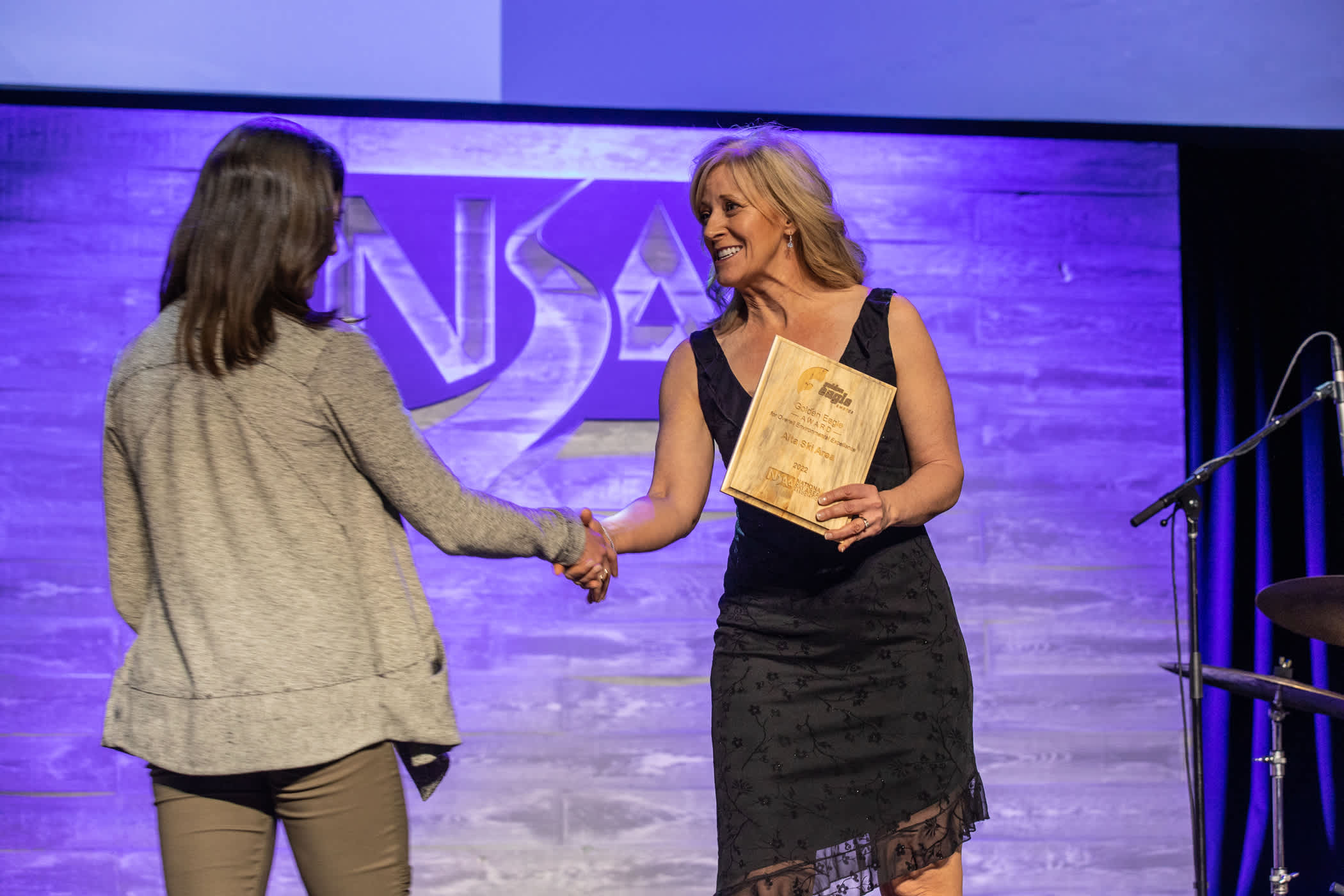
Alta Ski Area wins the National Ski Area Association Golden Eagle Award for Overall Environmental Excellence
2015
Historically-low Snowfall
The Collins Study Plot records just 323.5 inches of snow during the 2014–15 season. The Alta Guard Study Plot records just 274 inches. Both are the lowest seasonal snowfall totals on record.
2017
Supreme lift upgraded
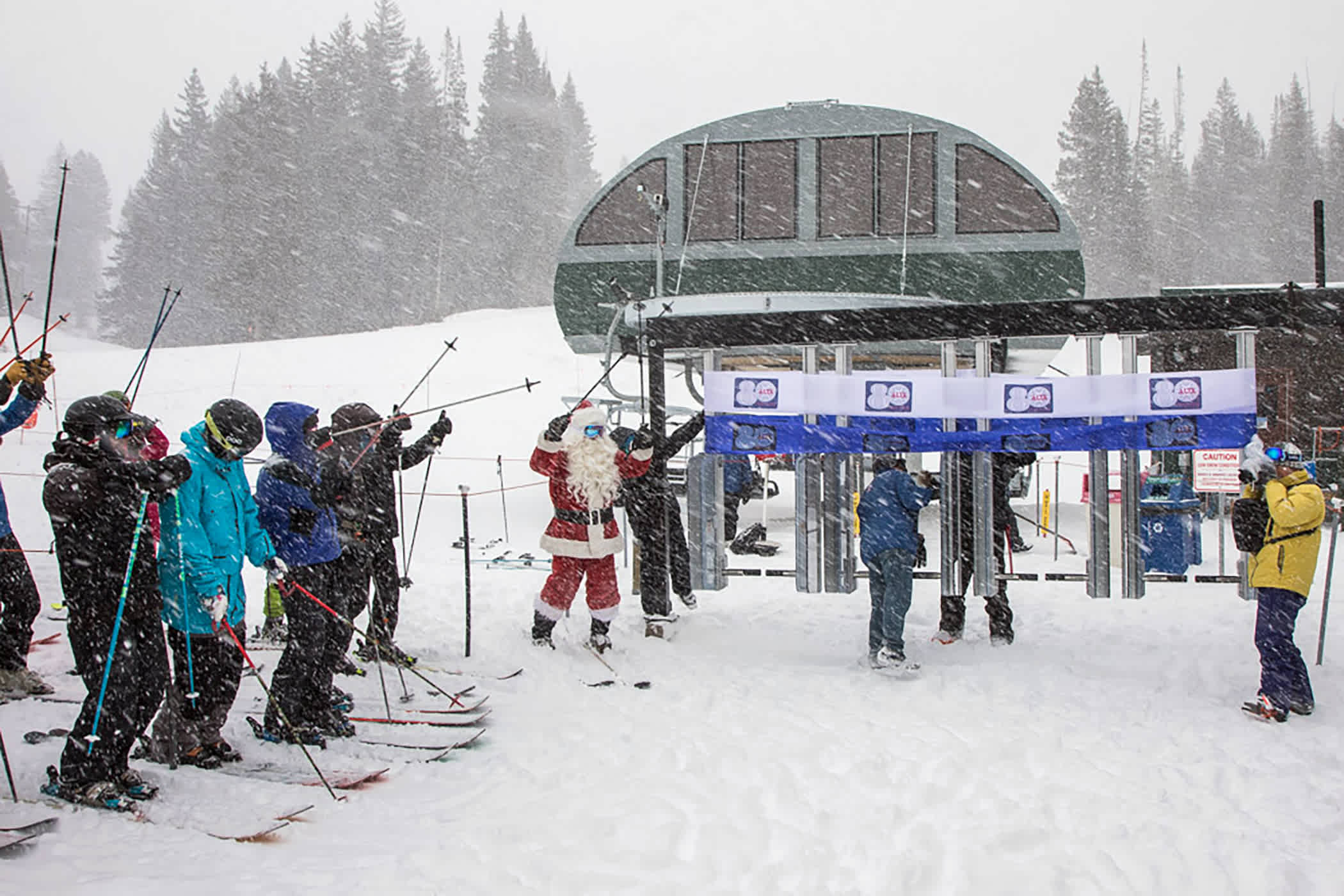
Detachable high-speed quad lift from Leitner-Poma—including an eight-degree bend to maintain existing liftlines—replaces both Supreme and Cecret lifts.
- NSAA & Ski Magazine Hero of Sustainability Award.
- Mike Maughan named Alta's fourth General Manager.
2020
COVID-19 Global Pandemic
On March 15th, Alta Ski Area closes due to the COVID-19 pandemic. Alta Ski Area would not reopen until the fall.
2022
Sunnyside becomes Alta’s first six-person lift
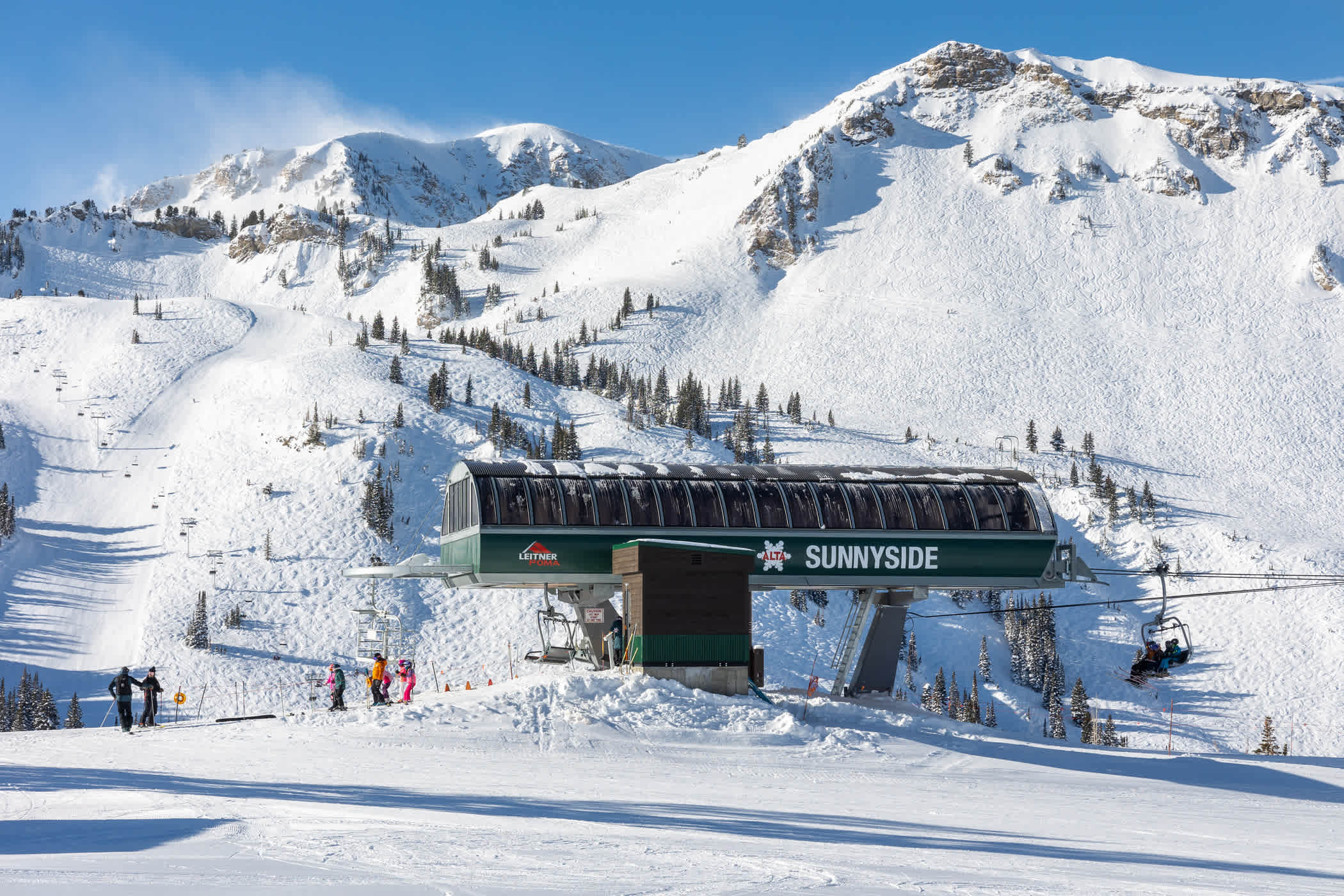
The Sunnyside lift is upgraded to a detachable high-speed six-person lift from Leitner-Poma. Global supply chain issues delay the opening of the lift until January 21, 2023.
- Alta wins NSAA Golden Eagle Award for Overall Environmental Excellence.
- Alta commits to matching 100% of its annual electricity use with renewable energy.
2023
903 Inches of Snow—the Snowiest Season on Record
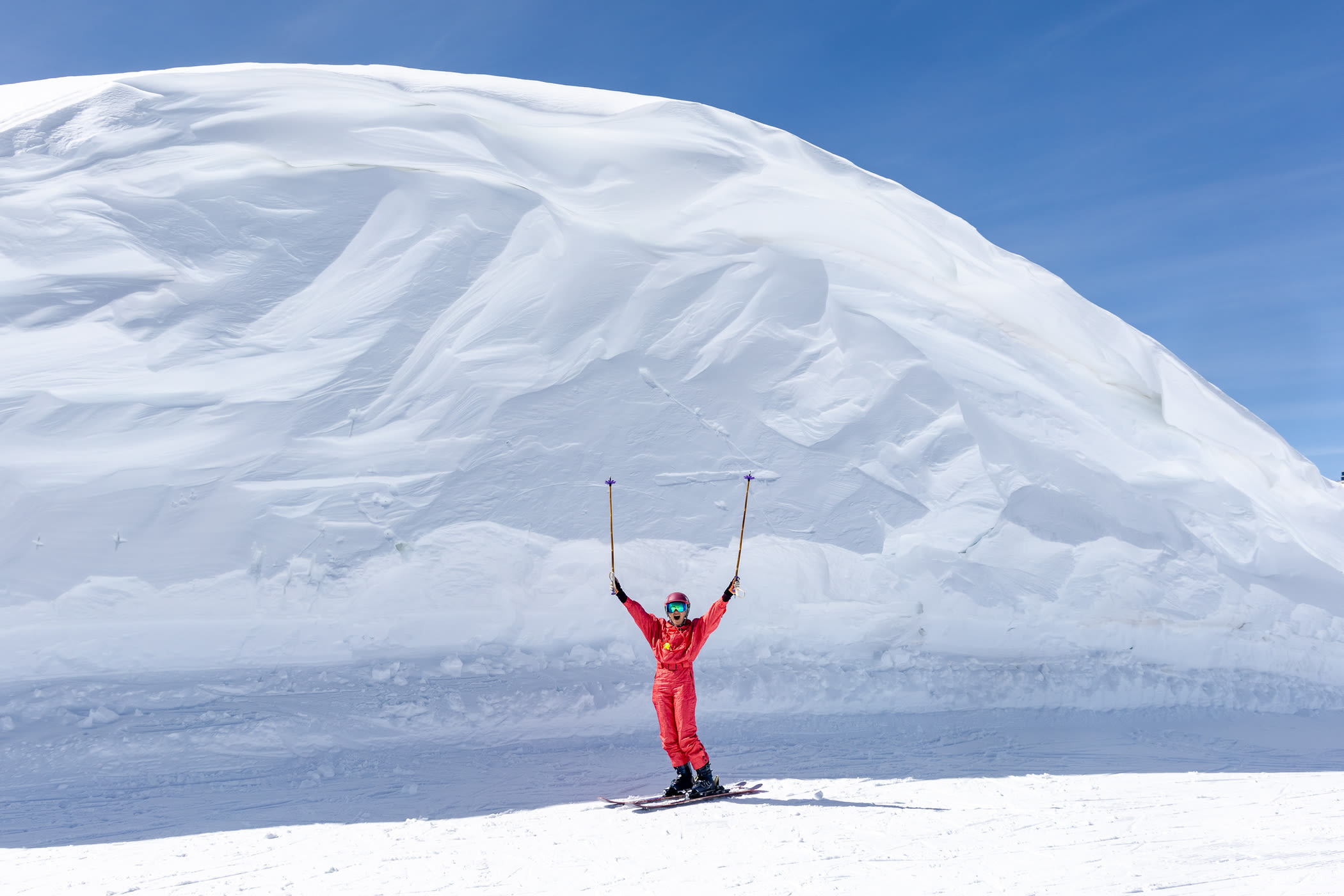
Alta received 903 inches of snow during the 2022–23 season—shattering the seasonal snowfall record of 748 inches. March 2023 sees 228 inches of snow—the snowiest single month on record.
- Albion lift is retired in the spring of 2023.
- Alta Ski Area retires the 105mm Howitzer for use in the ski area. New Remote Avalanche Control (RACs) devices are installed on Mount Baldy.
2024
Two New Covered Ski Conveyors
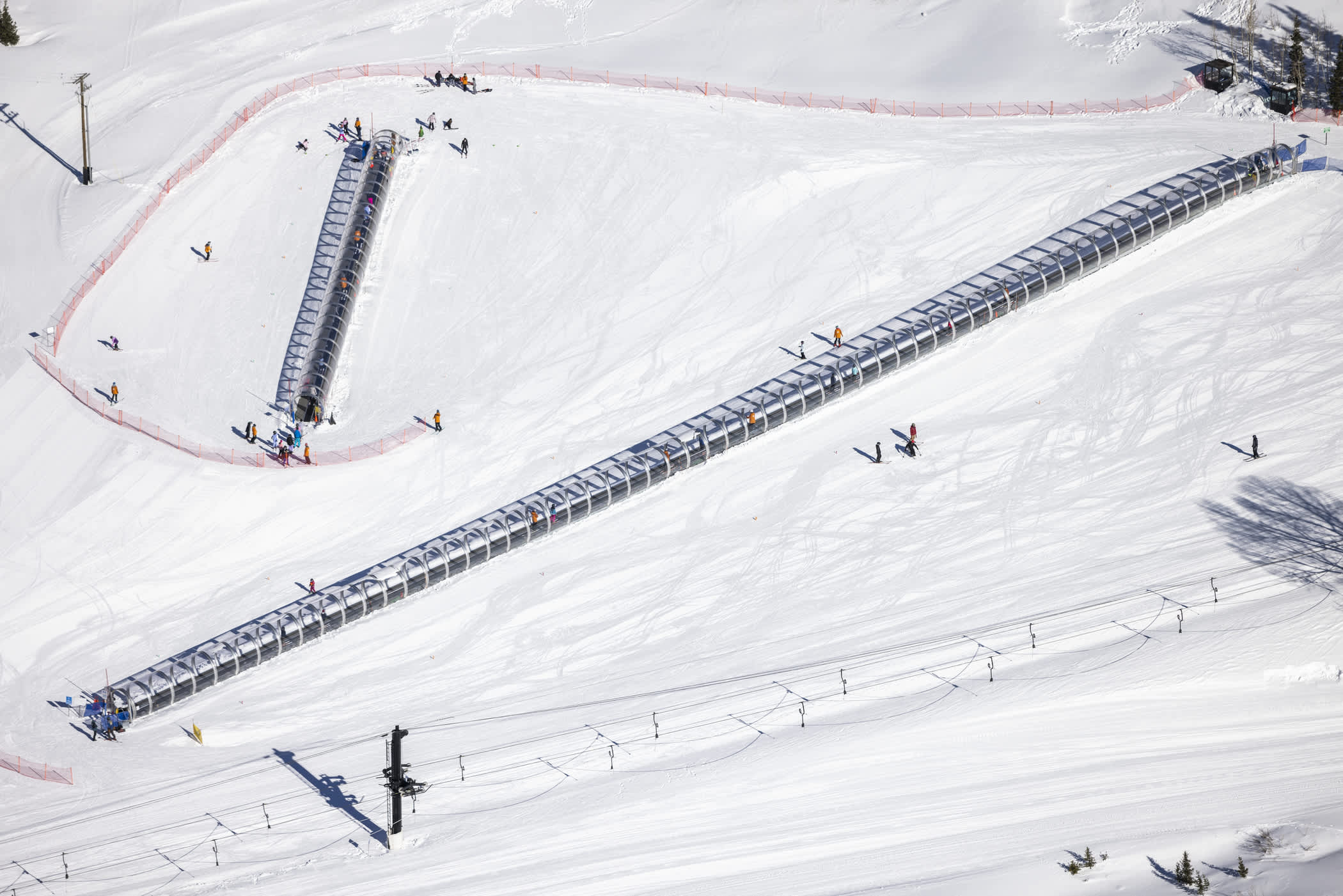
Big Griz and Little Griz open in the Albion base area, greatly expanding Alta’s learn-to-ski area.
2025
Supreme Realignment
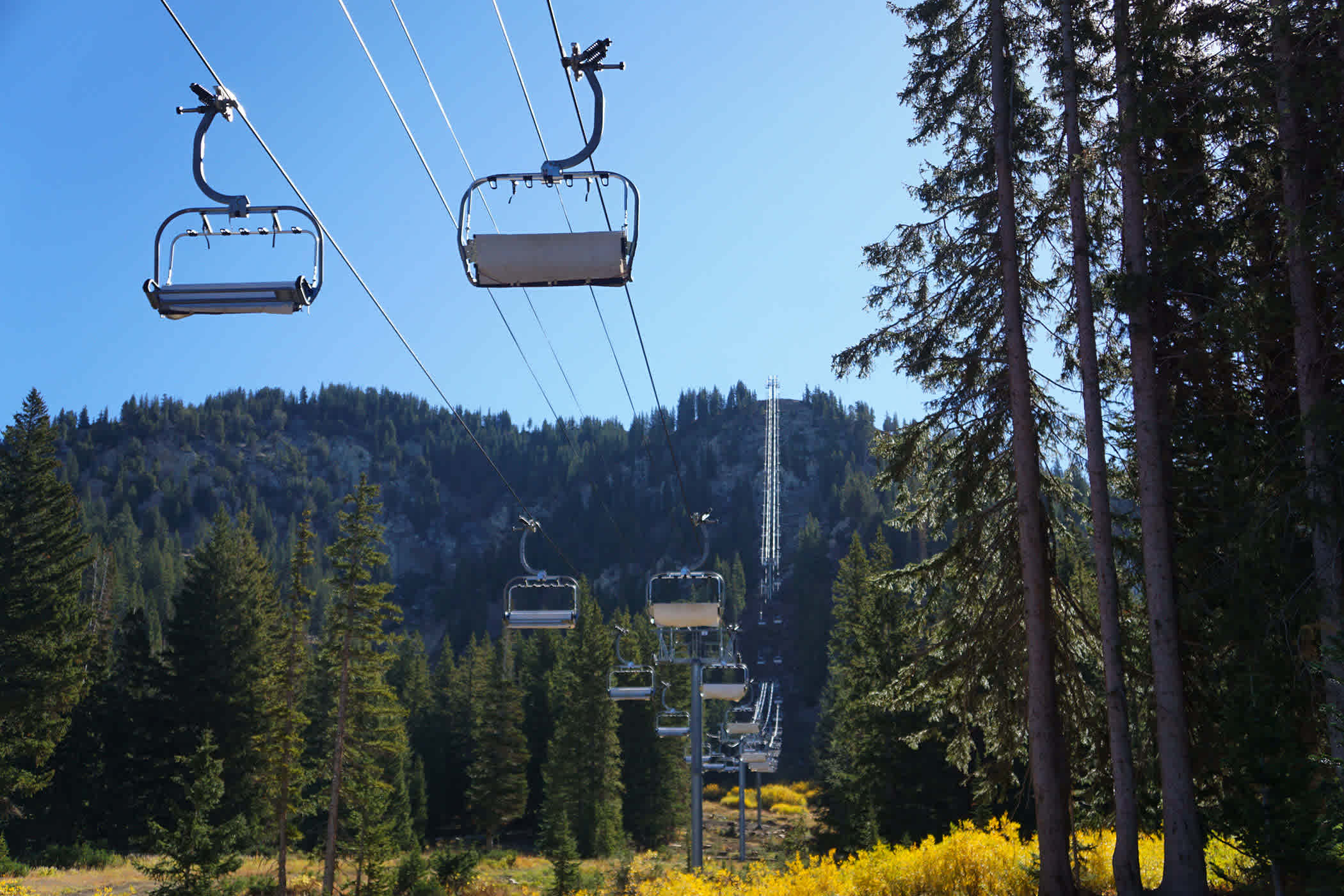
Supreme lift—a detachable high-speed quad from Leitner-Poma—is realigned to create a straighter lift alignment, eliminating the eight-degree bend.
